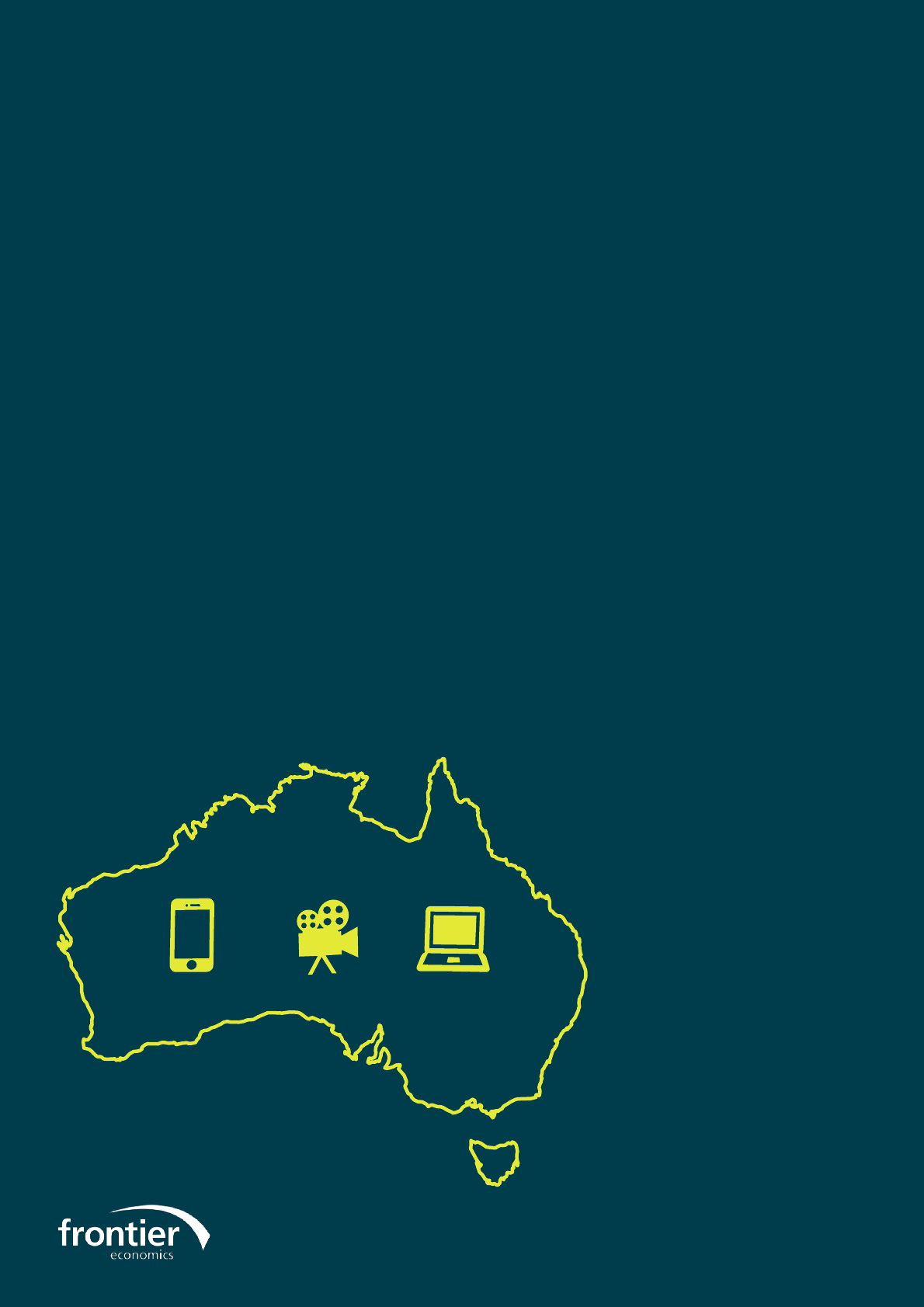
THE ECONOMIC
IMPACT OF VIDEO
ON
-DEMAND
SERVICES IN
AUSTRALIA
2022
WWW.FRONTIER-ECONOMICS.COM
BERLIN | BRUSSELS | COLOGNE | DUBLIN | LONDON | MADRID | PARIS
THE ECONOMIC
IMPACT OF VIDEO
ON-DEMAND
SERVICES IN
AUSTRALIA
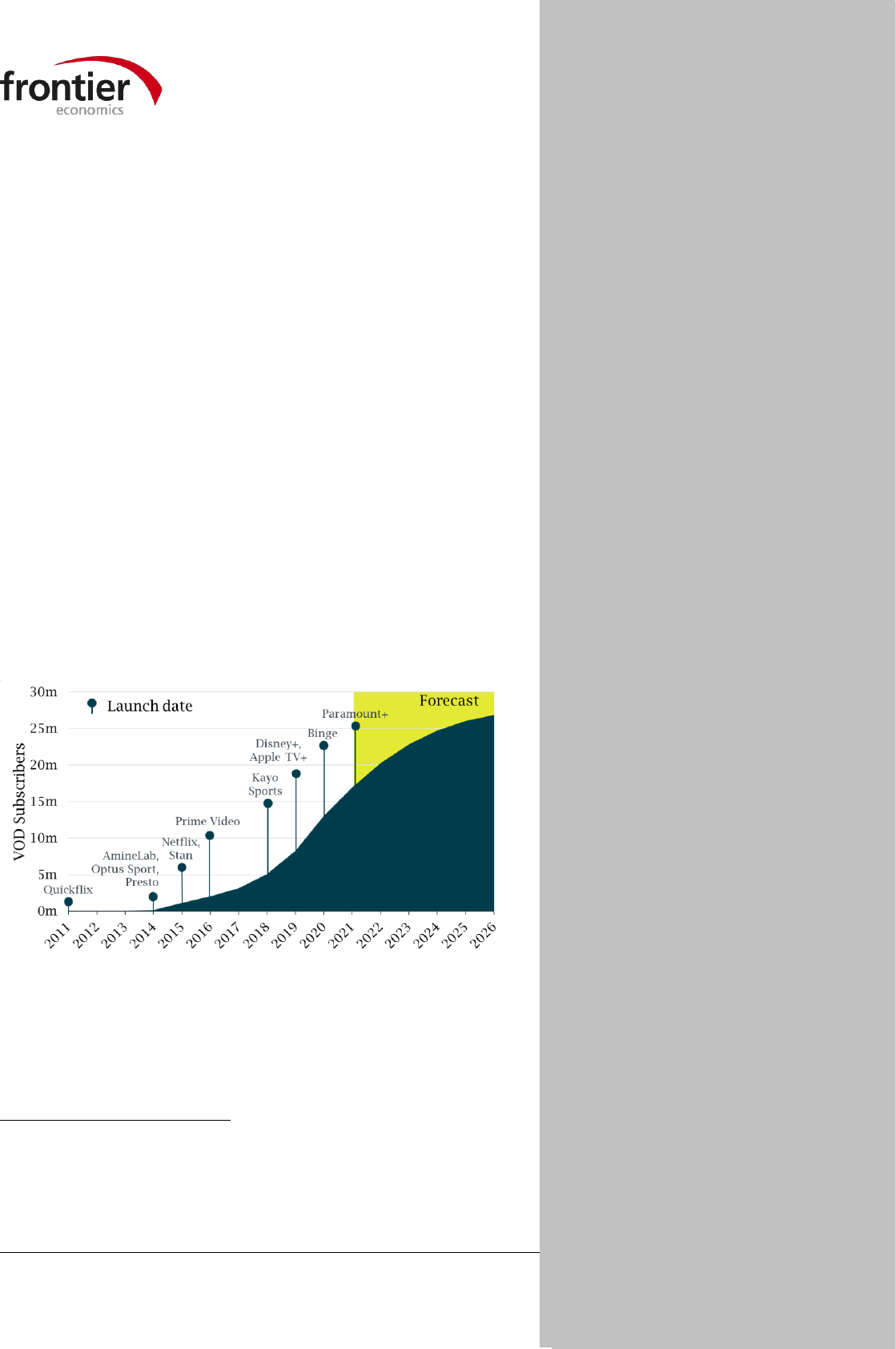
WWW.FRONTIER-ECONOMICS.COM | 2
EXECUTIVE SUMMARY
services make significant
investments in Australian content
and the AV industry, creating jobs
and promoting local content. VOD
services are in high demand from
consumers. This drives investment
by VOD services in high-quality
productions made in Australia that
they can then showcase to global
audiences.
These investments bring benefits to
the economy and society more
broadly. Investments in training or
infrastructure spill over to the AV
sector as a whole, spur tourism,
enhance Australia’s reputation and
support wider social goals.
Investment in Australian content is
already high. If policies are
considered, total impacts need to be
assessed and they should focus on
maintaining incentives and ensuring
Australia remains an attractive place
to produce. Some policies can boost
investment, but others can act as
deterrents. We have found that tough
policy restrictions reduce
broadcasting exports and are
associated with lower investment in
content.
This White Paper summarises
research Frontier Economics has
undertaken into the economic impact
of protectionist policies in video
content production. It also highlights
the economic impact that VOD
services have in Australia, and the
implications for policymakers who
wish to encourage and benefit from
such investments.
THE ECONOMIC IMPACT OF
VIDEO ON-DEMAND
SERVICES IN AUSTRALIA
1. VOD services are starting to take off in Australia
Australia supports a vibrant video on-demand (VOD)
*
sector with
consumers recently spoilt for choice of services. The popularity of
the services, and the local content they offer, has been growing
and there were nearly 13m Australians holding a VOD
subscription in 2020 (Figure 1).
1
Though the sector is relatively
young, with VOD services launching later in Australia compared
with other countries, already 72% of internet users in Australia
use VOD at least once a week,
2
spending 40% of their time on VOD
services watching local content.
3
VOD related revenue is increasing. Revenue generated by
Australia’s broadcasting and online video sector grew by 9%
between 2010 and 2020, following the entry of VOD services,
*
The term video on-demand (VOD) refers to professional and curated online video
content and does not include user-generated platforms such as YouTube.
Alternative terms can be used to describe video on-demand services, including
direct-to-consumer services (DTC), online curated content (OCC) and online
subscription services.
FIGURE 1 GROWTH OF VOD SUBSCRIBERS OVER TIME
Source: Ampere
Note: VOD subscribers include any VOD subscription customers that pay a fee. Launch date is
the year the service could be first used in Australia. Figures from 2021 are forecast
EXECUTIVE SUMMARY
Video on-demand (VOD) services
were launched later in Australia
compared with other countries but
already make important direct and
indirect economic contributions to
the country’s audiovisual (AV)
industry. VOD services make
significant investments in Australian
content and the AV industry,
creating jobs and promoting local
content. VOD services are in high
demand from consumers. This drives
investment by VOD services in high-
quality productions made in
Australia that they can then
showcase to global audiences.
These investments bring benefits to
the economy and society more
broadly. Investments in training or
infrastructure spill over to the AV
sector as a whole, spur tourism,
enhance Australia’s reputation and
support wider social goals.
Investment in Australian content is
already high. If policies are
considered, total impacts need to be
assessed and they should focus on
maintaining incentives and ensuring
Australia remains an attractive place
to produce. Some policies can boost
investment, but others can act as
deterrents. We have found that tough
policy restrictions reduce
broadcasting exports and are
associated with lower investment in
content.
This White Paper summarises
research Frontier Economics has
undertaken into the economic impact
of protectionist policies in video
content production. It also highlights
the economic impact that VOD
services have in Australia, and the
implications for policymakers who
wish to encourage and benefit from
such investments.
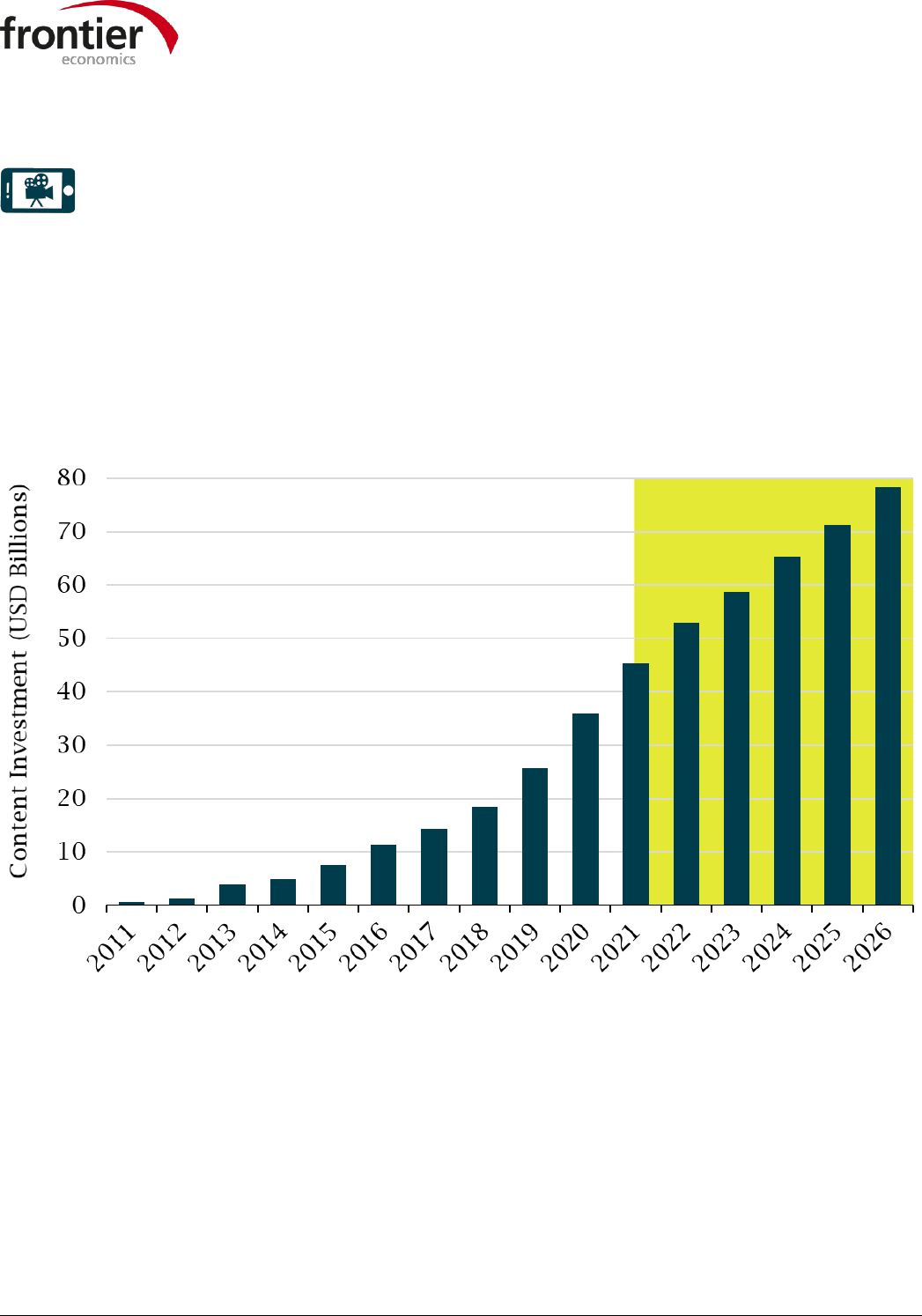
WWW.FRONTIER-ECONOMICS.COM | 3
which now include Netflix, Stan, Binge, Disney+ and more. Since 2011, the revenue of VOD services has
risen to $940m (AUD1.4bn
4
)
5
, and it is projected to rise to $2.5bn (AUD3.6bn) by 2025.
6
GLOBAL INVESTMENT, LOCAL IMPACT
2. VOD services are generating a creative content boom
VOD services invest heavily in content to support their services globally. In 2020, they directly invested
$36bn (AUD52.3bn) in VOD content worldwide, covering original and licensed titles. This sum is likely to
increase to $78bn (AUD113bn) by 2026.
FIGURE 2 GLOBAL VOD CONTENT INVESTMENT 2011 TO 2026
Source: Ampere
Note: VOD content investment includes content spend by both subscription VOD and ad-based VOD companies
The significant increase in content investment in the pipeline includes:
The Walt Disney Company’s plans to invest $14bn-16bn (AUD20.3bn-23.3bn) per year in global
VOD content by 2024;
ViacomCBS’s plans to ramp up investment in VOD content to $5bn (AUD7.3bn) in 2024;
7
A pledge by WarnerMedia’s parent company, AT&T, to invest $4bn (AUD5.8bn) in HBO Max,
including HBO Max original programmes which are available on various platforms in Australia
including Binge, in the three years through 2022;
8
and,
Netflix will spend $28bn (AUD41bn) a year by 2028.
9
Forecast

WWW.FRONTIER-ECONOMICS.COM | 4
3. VOD services are investing in Australian content
Frontier Economics’ research has found that there is strong consumer demand for Australian content and
that this drives investments in Australian content by VOD services and independent producers. As a
country’s VOD service subscriber base grows, so do the incentives to produce local content.
Hence, the overall geographic distribution of VOD investment in original titles is broadly proportionate to
each country’s number of VOD subscribers (Figure 3). This relationship holds in Australia. Subscribers are
not the only determinant of investment in local content as success of previous content exports from the
country (US, UK, South Korea, Canada), commonality of the spoken language (such as Spanish or English),
or comparatively lower local production costs (Mexico, Indonesia) can also determine investment.
It is important to note that leading content providers invest in Australian content and the Australian
industry not only for their VOD services but for all their distribution channels, including linear and
theatrical distribution. In 2019, The Walt Disney Company, NBCU, WarnerMedia and ViacomCBS collectively
poured $45bn (AUD65bn) into content spending and creation globally (excluding sports) across their
distribution channels, which they will partly monetise on their VOD services (Disney+, Peacock, HBO Max
and Paramount+ respectively).
FIGURE 3 RELATIONSHIP BETWEEN VOD SUBSCRIBERS AND MARKET-SPECIFIC VOD “ORIGINAL” TITLES
Source: Frontier analysis of Ampere and Media Partners Asia data
Note: VOD subscribers include any global subscription VOD customers in 2019 who paid a fee. The 2019 values of VOD subscribers are used as they are the
most comparable to the VOD originals data which covers investment pre-pandemic. Pre-pandemic data has been used because of the uneven impact of the
pandemic on AV industries across the world. A title has been included as a VOD original title if it was produced by the VOD service and released only on the
VOD service. The sample of titles reflects the catalogues of VOD services available in the following markets: Argentina, Australia, Brazil, Canada, Colombia,
India, Indonesia, Mexico, Korea and Taiwan. VOD services included in the sample of titles are: Netflix (18% of titles), Amazon Prime Video (18%), Hotstar
(7%), Wavve (7%), Foxtel Now (6%), iflix (5%), Eros Now (5%), WatchaPlay (4%), HamiVideo (4%), Hooq (4%), Claro Video (3%), friDay (3%), myVideo (3%),
myVideo (2%), Looke (2%), SonyLiv (2%), VIU (1%). Others (inc. Globo Play, CraveTV, Vidio, Stan, Disney+, Apple TV+ and Crunchyroll – 10%). The data
includes content titles that were available between June 2017 and April 2020, and an additional set of titles that were available in October 2020 in
Indonesia, so does not reflect the most recent releases. All markets that have had a VOD original title produced in their market are included in the analysis.
China has been excluded as data was not available. Note that US and India are not included in the figure since they are outside the limits of the scale. See
technical annex for further detail.
Argentina
Australia
Brazil
Canada
Colombia
France
Germany
Indonesia
Italy
Japan
Mexico
South
Korea
Spain
Taiwan
UK
0
50
100
150
200
0m 10m 20m 30m 40m 50m
Number of VOD Original Titles
Number of VOD Subscribers
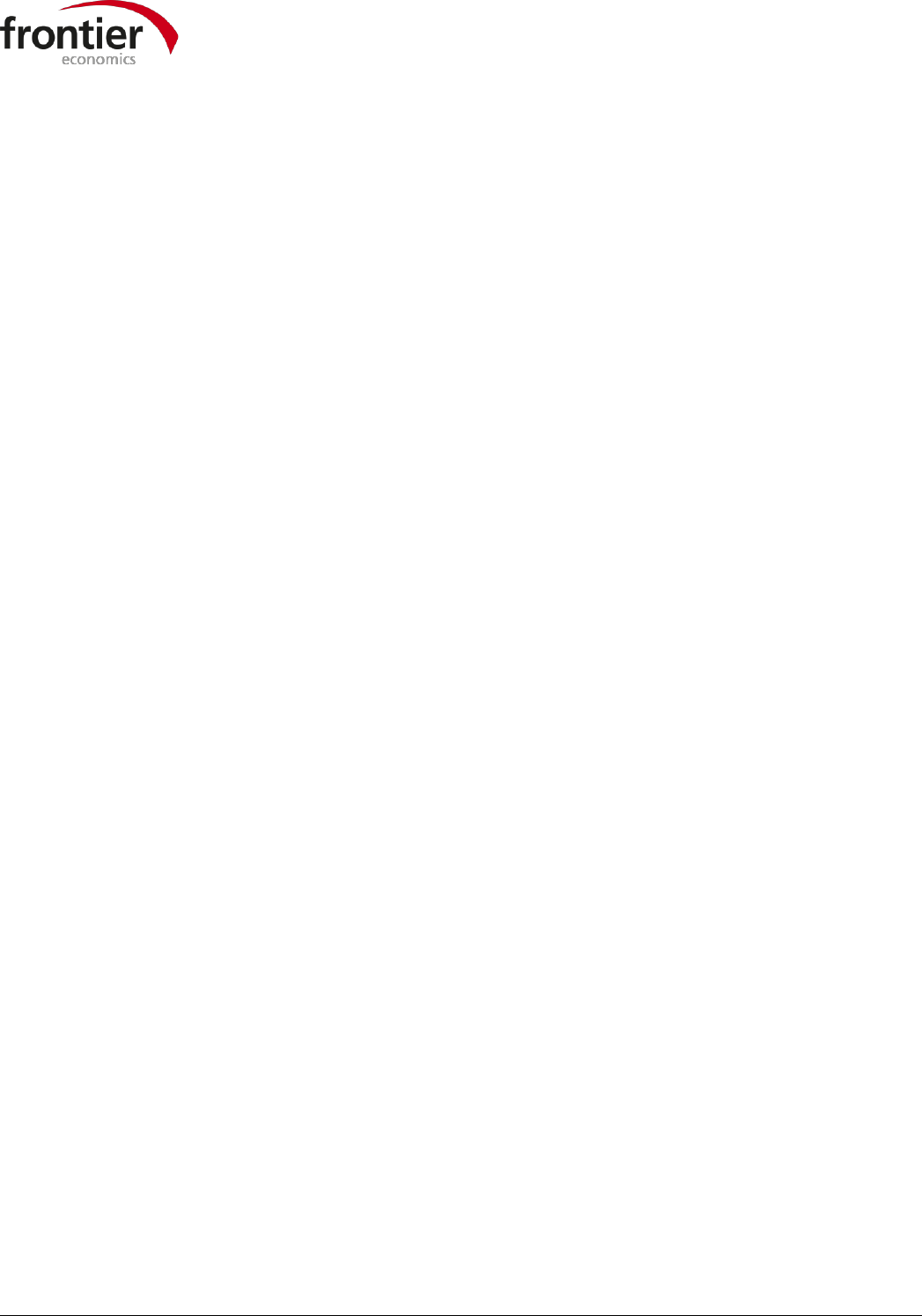
WWW.FRONTIER-ECONOMICS.COM | 5
The relationship set out in Figure 3 is likely to continue to hold in Australia in coming years. In addition,
since 2019, following the further entry of new VOD services in Australia, there has been a steady increase
in subscribers, and corresponding new investment in local content with VOD services making significant
investments in content in Australia, both individually and in partnership with traditional broadcasters.
Amazon Prime Video, Disney+, Netflix and Stan spent AUD629m on Australian and Australian-
related programs in the 2020-21 financial year
10
(of which AUD179m was spent on Australian
content
11
and AUD450m was invested in “Australian-related content”
12
). Much of this investment
focused on commissioning new or acquiring Australian drama, documentaries and children’s
programmes. The spend by the four VOD services increased compared to the 2019-20 financial
year as investment in Australian programs increased by 17% from AUD153m and investment in
“Australian-related content” nearly quadrupled from AUD115m.
13
ViacomCBS, announced that it has invested in exclusive Australian productions for its recently
launched Paramount+ including The Last King of the Cross, Spreadsheet and 6 Festivals.
ViacomCBS’s head of Australian content Bev McGarvey said at launch that “We want to be able to
use Paramount+ to tell strong Australian stories.
14
Following the launch in October 2021, at the
ViacomCBS Australian Upfronts, further local content investments were announced, including a
new season of popular Australian drama Five Bedrooms, along with documentary series Couples
Therapy, and a major new reality adventure series The Bridge that will be filmed entirely in
Tasmania.
15
At the event ViacomCBS’s Bev McGarvey said “Our selection really captures the essence
of what makes entertainment in Australia so powerful. There’s depth in the narratives and
complexity to the characters; the production values are world class; and our cast and local crews
only underline the diverse, talented bunch we are.”
Since launch in 2015 Stan has commissioned local productions with budgets totaling around
AUD300m,
16
and the Australian owned and operated streaming service is continuing to increase
its investment in local television and film. The strategy will see Stan ramp up its output to deliver
around 30% of its first-run slate from original productions.
Since 2019, Amazon Prime Video has commissioned 14 Amazon Original series in Australia,
investing AUD150m in local productions and creating more than 2,500 jobs. Amazon is investing
in a diverse range of Austrlian content, which includes comedies, documentaries, reality and
scripted dramas. Tyler Bern, Head of Content, Prime Video Australia, said that “We know that
viewers in Australia want to see new, fresh, unique and authentic stories that they can connect with,
and we’re committed to producing diverse Australian programming for Prime members globally”.
17
Netflix invested AUD110m in the four years to 2020 in Australian original and co-produced
children’s programs alone.
18
And in 2020, Netflix invested in 16 new Australian titles such as its
AUD36m investment in the recent original series Clickbait.
19
Disney in the fiscal year ending June 2021, in addition to filming two Marvel movies back to back
in Sydney, funded the Australian crime comedy Mr Inbetween, brought 9 Perfect Strangers with
Nicole Kidman to Byron Bay and shot Limitless and Shark Beach with Chris Hemsworth in
Australia. In addition, Disney+ Australia is now making Shipwreck Hunters Australia a six-part
documentary series filming now off the coast of Western Australia.
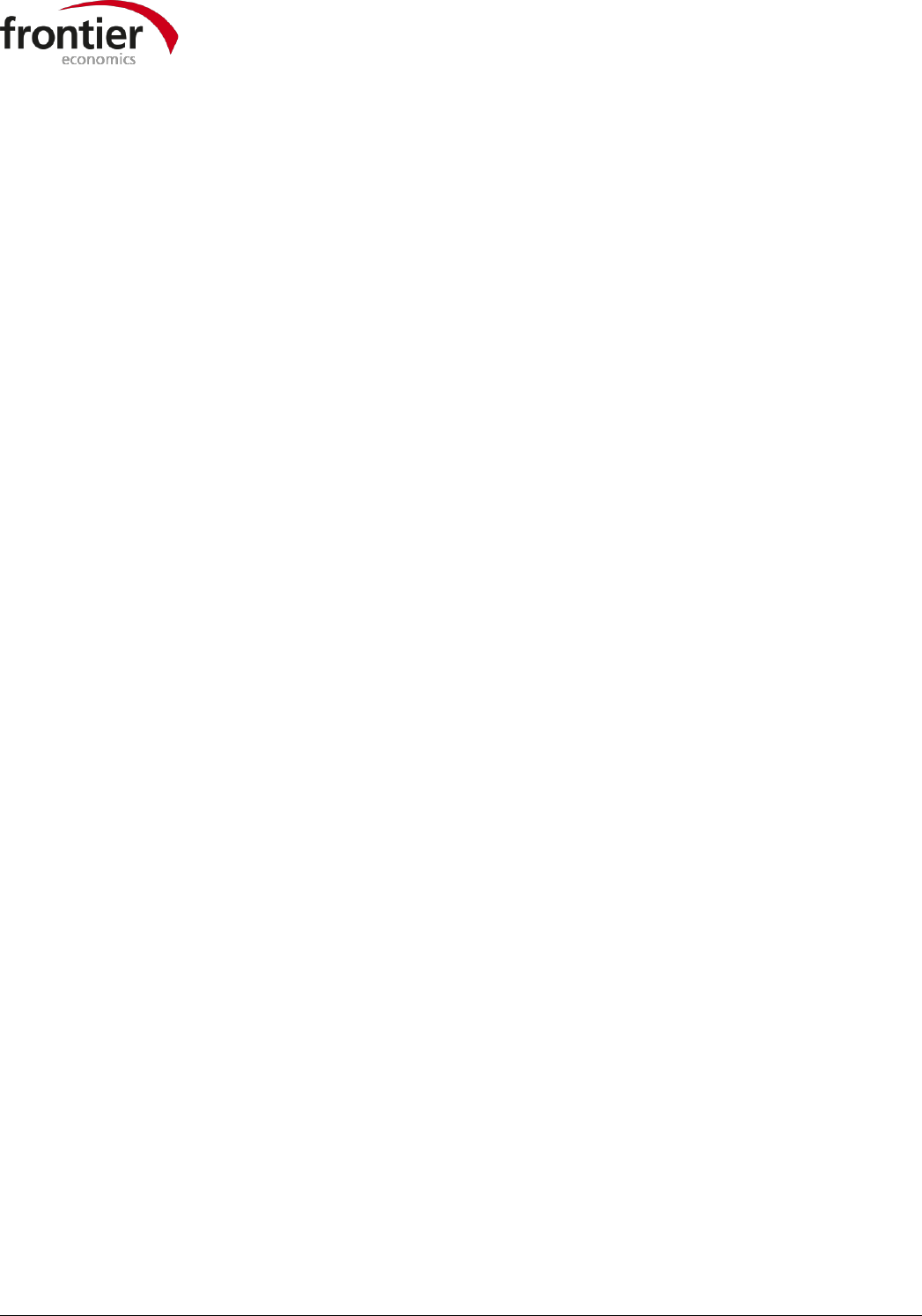
WWW.FRONTIER-ECONOMICS.COM | 6
Screen Australia has found that investment by VOD services in drama content, some of which is
outlined above, has increasingly been in high-end content as the average cost-per-hour of the titles
has increased over the last five years.
20
High-end, high budget content can have larger economic
impacts through job creation, increased exports due to potentially being more popular globally
and through wider spending on inputs needed for production.
As illustrated, VOD services have committed to individual specific investments in Australian content.
However, on top of this, VOD services and the media companies supporting them also engage in complex
investment partnerships and co-productions.
4. VOD services are creating jobs and are delivering returns for the economy
The media companies offering VOD services create jobs directly in the production sector across activities
within the AV ecosystem. These include VOD services, feature films, TV content production, physical
production facilities, digital visual effects, and the distribution of pay TV channels. Additionally, research
finds that 60% of production costs are on average incurred in the general economy outside the AV sector,
for example on catering, hospitality, construction and legal services.
21
This spending broadens the
employment benefits and the media sector’s contribution to the Australian tax base.
The Australian media sector is a significant segment of the domestic economy, employing
approximately 90,000 Australians in 2018/19 and generating an estimated AUD47.7bn of
domestic revenue.
22
Investment in content, even content that is not considered Australian, can deliver returns for the
local economy. In the 2020-21 financial year investment in foreign filming productions in Australia
by Amazon Prime Video, Disney+, Netflix and Stan employed 56 Australian cast, 2,356 Australian
crew and over 5,000 Australian extras.
23
In 2020/21 a record AUD1.9bn was invested in Australia, across both Australian content and
foreign filming, on scripted drama content for film and TV. This is an 84% increase on 2019/20
and a 46% increase on the previous highest amount invested in 2016/17. In addition, a record
AUD874m of this was invested in Australian content.
24
The investment in content in 2020/21 was
spread throughout Australia as shown in Figure 4.
25
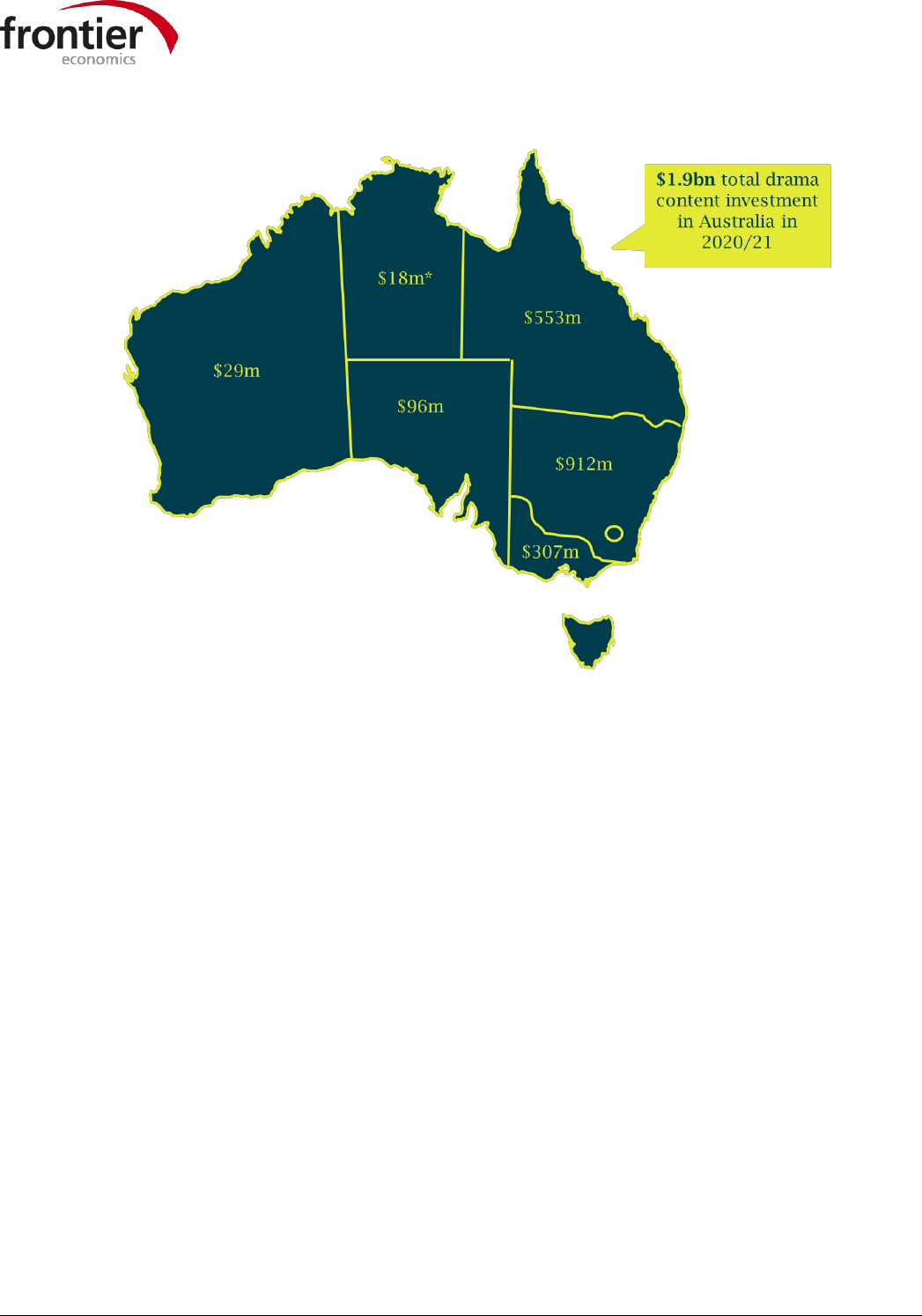
WWW.FRONTIER-ECONOMICS.COM | 7
FIGURE 4 SCRIPTED DRAMA CONTENT INVESTMENT IN 2020/21 BY STATE AND TERRITORY
Source: Screen Australia, Drama Report - Production of feature films, TV and online drama in Australia in 2020/21
Note: All values are in AUD. *The AUD18m in Northern Territory represents the scripted drama content investment across Northern Territory, Tasmania
and Australian Capital Territory as it is combined in the Screen Australia report.
Between 2017 and 2020, ViacomCBS’s investment in global film and television production in
Australia has delivered more than AUD130m to the local economy, supporting 990 jobs and
more than 700 Australian businesses.
26
This included popular 2019 childrens film Dora and the
Lost Cities of Gold, filmed on the Gold Coast. The cast included Eva Longoria who said of the local
film crew, “Brilliant, they were so great, they had big project after big project, so…it was one of the
most experienced crews I’ve ever seen just for the amount of work they’re continuously doing there.”
While Isabela Moner (who played Dora) said, “they (the production cast and crew) were wonderful,
Aussies are such good people. Specifically, I’ve never seen so many women crew members which is
so cool, really, really, cool and it felt like such a great environment to be surrounded by.”
27
Just one production can have a significant impact on the local economy.
In 2016, Disney spent a reported $180m (AUD262m) in Queensland shooting Thor: Ragnarok.
The production, now on Disney+, created more than 2,000 jobs for local cast, crew and production
office personnel.
28
In addition, the production of Thor: Love & Thunder (due for release in 2022),
filmed at Fox Studios Australia in New South Wales, is estimated to have brought $178m
(AUD259m) to the NSW economy, created 2,500 jobs and used services from 1,650 local
businesses.
29
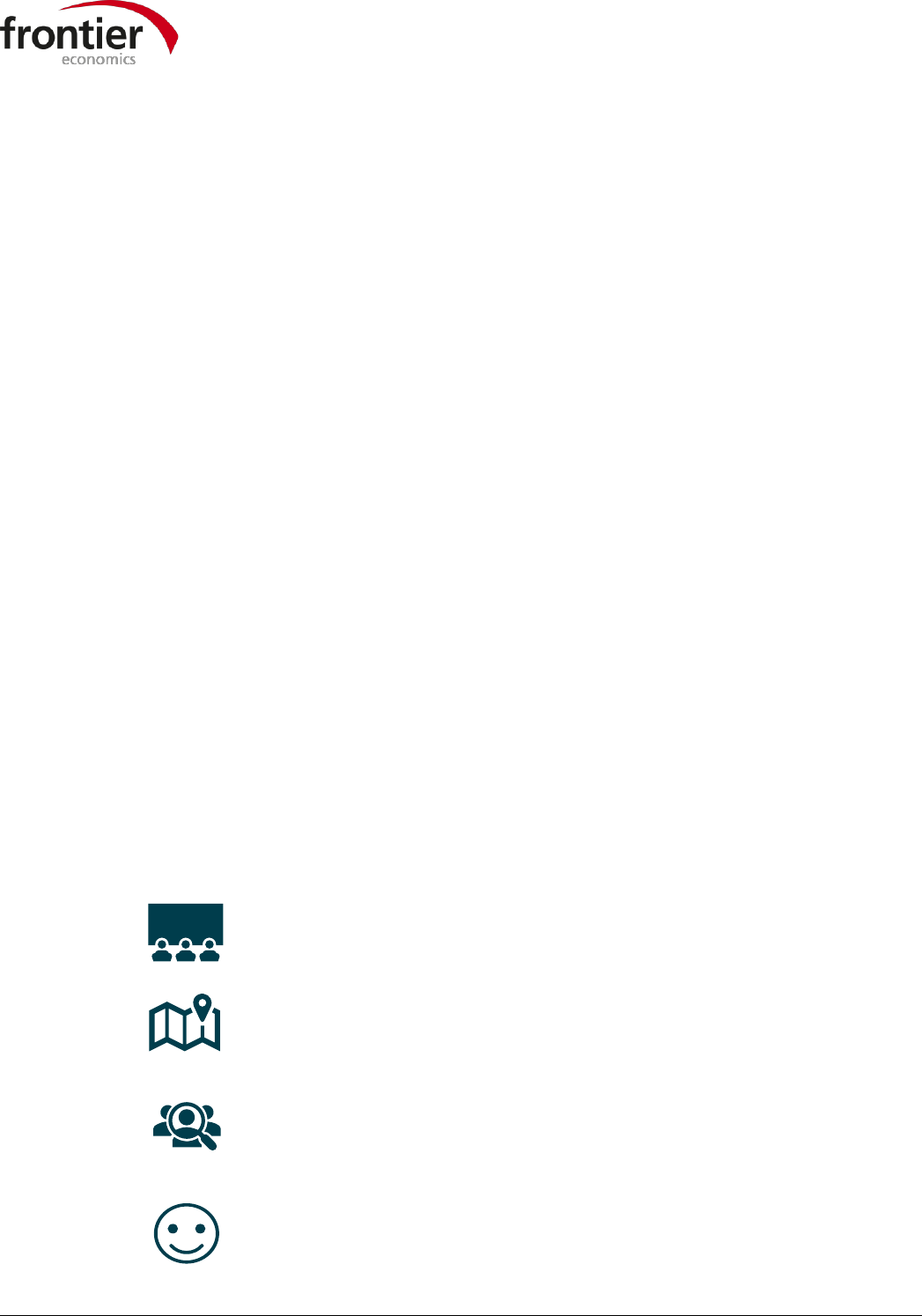
WWW.FRONTIER-ECONOMICS.COM | 8
Apple TV+’s AUD55m investment in the original Shantaram series, which is still in production,
will provide up to 1,000 jobs in Victoria during production.
30
The series is based on a popular
Australian novel of the same name by Gregory David Roberts.
Netflix’s investment in Clickbait, which was written, co-created and produced in Victoria, brought
more than AUD36m of new international investment and engaged around 540 cast, crew and
extras and used the services of around 290 local businesses.
31
VOD productions can also bring economic activity outside city centres, to regional Australia. The
Hon Paul Fletcher MP, (Minister for Communications, Urban Infrastructure, Cities and the Arts) has
said Amazon Studio’s filming of season 2 of The Wilds was expected to bring investment of more
than AUD73m to the Australian economy and create more than 270 jobs for cast and crew.
32
At a
local level, filming at Deadman’s Beach, Frenchman’s Beach, South Gorge, Flinders Beach and on
Southern Moreton Bay is estimated by Redland City Council to have provided a direct economic
injection of more than AUD800,000 to the island and Redlands Coast economy. The production
saw 200 cast and crew staying on the island, resulting in about 4,000 hotel nights with local
accommodation providers.
33
The show, which was co-produced by Amazon Studios and ABC
Signature Studios, engaged Brisbane-based production company Hoodlum Entertainment as its
service company in Australia.
5. Australians are finding the local content they demand on VOD services
Frontier Economics surveyed 1,107 internet users in Australia and found they demand a diverse array of
content, both local and international, and that VOD services are delivering content consumers want and
love.
34
Consumers in Australia feel it is important that VOD services provide local content and Australian
consumers use VOD to watch local, Australian content. While the catalogues of VOD services offer
subscribers a wide mix of content from around the world, 40% of the content users stream is from
Australia.
40% OF HOURS WATCHED ON AUSTRALIAN VOD SERVICES WAS LOCAL,
AUSTRALIAN CONTENT
35
73% OF AUSTRALIANS CONSIDER IT IMPORTANT THAT THEIR VOD OR TV CONTENT
SERVICES PROVIDE AUSTRALIAN CONTENT
36
44% OF AUSTRALIAN VIEWERS THINK THAT THEIR VOD SERVICES PROVIDE A
GOOD, OR THE BEST LEVEL OF AUSTRALIAN CONTENT.
37
ONLY 15% DID NOT
THINK VOD SERVICES HAD ENOUGH AUSTRALIAN CONTENT.
58% OF CONSUMERS ARE SATISFIED WITH THE AMOUNT OF AUSTRALIAN
CONTENT ON THE VOD SERVICES THEY USE
38
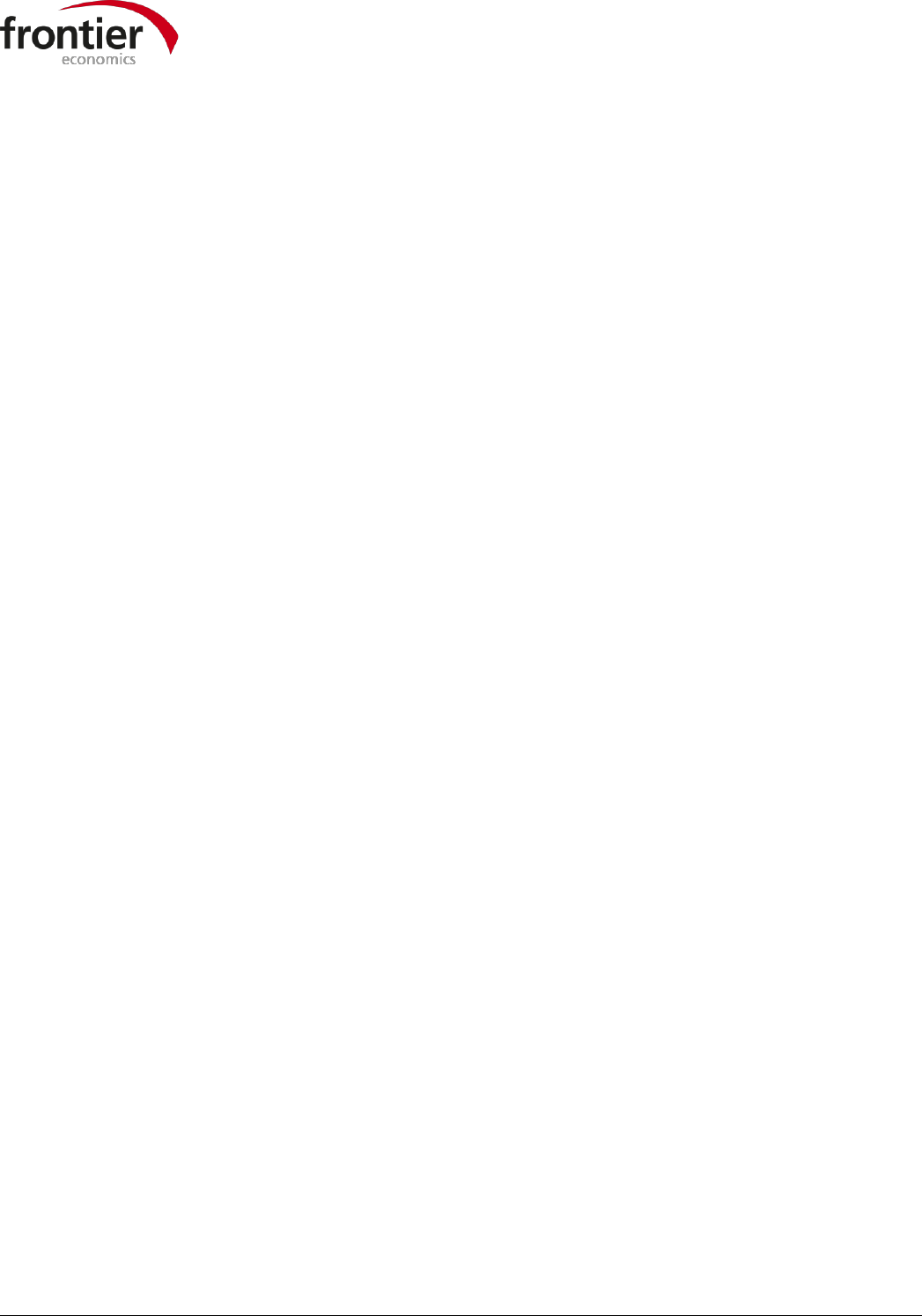
WWW.FRONTIER-ECONOMICS.COM | 9
6. VOD services are bringing Australian content to a wider world
International VOD services are able to expand the reach of Australian stories to global audiences. VOD
services offer an unprecedented global audience and reach diverse viewers, including niche audiences
around the world who seek Australian content. Australian content producers consider not just their
domestic audiences, but in addition how their content will appeal internationally. Indeed the Hon Paul
Fletcher MP (Minister for Communications, Urban Infrastructure, Cities and the Arts) has argued that “in
the internet era, it is more important than ever to work out what your strengths are – and where you are
going to be good enough to build not just a strong market share in Australia but a strong market share
globally”.
39
By meeting international demand for Australian made content, VOD services are supporting
local producers and Australian exports and promoting the country’s artists and culture.
As of June 2021, there were at least 626 Australian titles available in the US on VOD services, 530 avaliable
in Canada, 515 available in the UK, 185 in France, 162 in Japan, 161 in Mexico, 155 in Brazil and at least 42
available in India.
40
Examples of Australian content that have been popular worldwide include:
ABC and Netflix’s co-production The Inbestigators;
Australian docuseries, Love On The Spectrum, which is produced by ABC in Australia and was
picked up for international distribution by Netflix, helping increase awareness of the show;
Australian animated TV series Bluey which was released internationally on Disney+; and
Stan’s commission, No Activity, which has been distributed widely into several overseas markets,
and the format rights to the series were sold to CBS for a US adaptiation in 2017.
In particular, Australian children’s and young adult television programmes have benefited from the
additional support and exposure VOD services can provide. Canadian-Australian director, producer and
showrunner of Dive Club, a co-production between Netflix and Network Ten, Steve Jaggi highlighted the
ability of VOD services to reach global audiences saying “For a very tiny Australian teen show on a very
humble budget to have gone out and… we actually broke through in over a dozen territories into the adult
carousel Top 10 and it was on the kids carousel in over 50 territories. So, the number of eyeballs is obviously
in the many, many millions”.
41
As well as the additional exposure, VOD services have been keen to support
the Australian features of local content. Daley Pearson, who supported Bluey’s production, said that when
he took the title to market there was feedback from other distribution outlets that they might need to
change the distinctive Australian voices of the characters, but Disney were supportive; “Disney and Disney+
were one of the ones who supported it, which was why we were really attracted to go with them… They
really supported the show's DNA”.
42
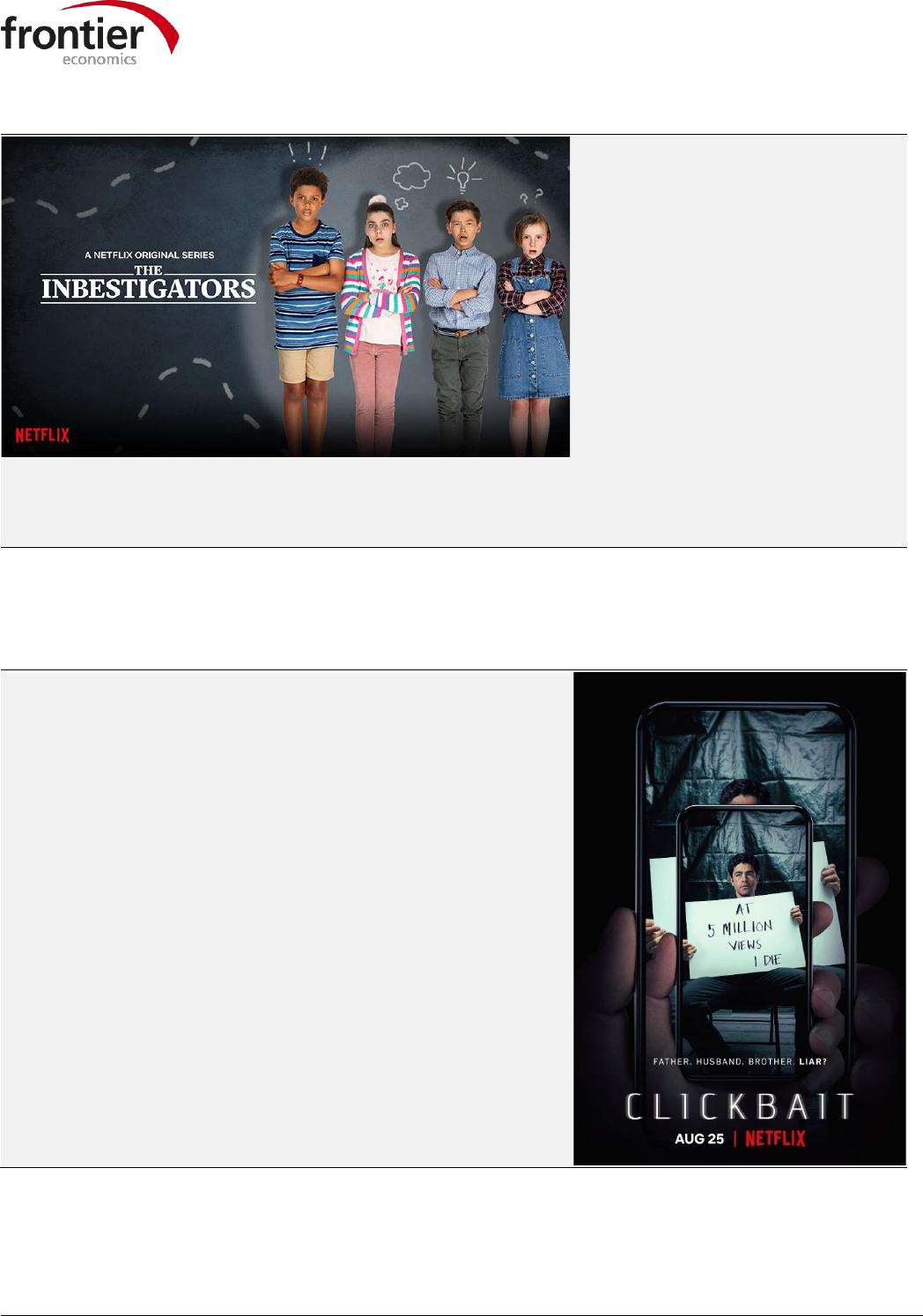
WWW.FRONTIER-ECONOMICS.COM | 10
CASE STUDY - CONTENT INVESTMENT IN AUSTRALIA:
THE INBESTIGATORS
The Inbestigators is a comedy-drama
about a kids’ detective agency that
was a co-production between ABC
and Netflix and produced by
Australian production company
Gristmill.
The creators, Robyn Butler and
Wayne Hope, say that the partnership
with Netflix allowed them to scale
and shoot two seasons
simultaneously.
The global audience for the
programme was demonstrated to the creators when they received fan art and re-enactment videos from
children in Brazil, Romania and South Korea who watched The Inbestigators on Netflix. Robyn Butler said,
“That was extraordinary to us because everything in the show is so specifically Australian”.
43
CASE STUDY - CONTENT INVESTMENT IN AUSTRALIA:
CLICKBAIT
Recently released Netflix series Clickbait was the first Netflix
original series to be produced in Victoria.
44
It was produced at
Docklands Studios Melbourne involving a majority Australian
cast and crew and it was supported by the Location Offset and
Incentive fund, and Film Victoria's Production Incentive
Attraction Fund. Australian co-creator Tony Ayres said that “We
are equally delighted to produce this US show in Melbourne. It’s
an opportunity to showcase the international level of Australian
talent both behind and in front of the camera.”
The show hit the number one most watched spot on Netflix in
more than 20 countries including Australia, the USA and the UK.
Netflix helped this made-in-Australia content become a global
success. Tony Ayres also said that “I think this proves that we
can make work in Victoria that actually competes on the world
stage, and can get the attention of the world.”
45
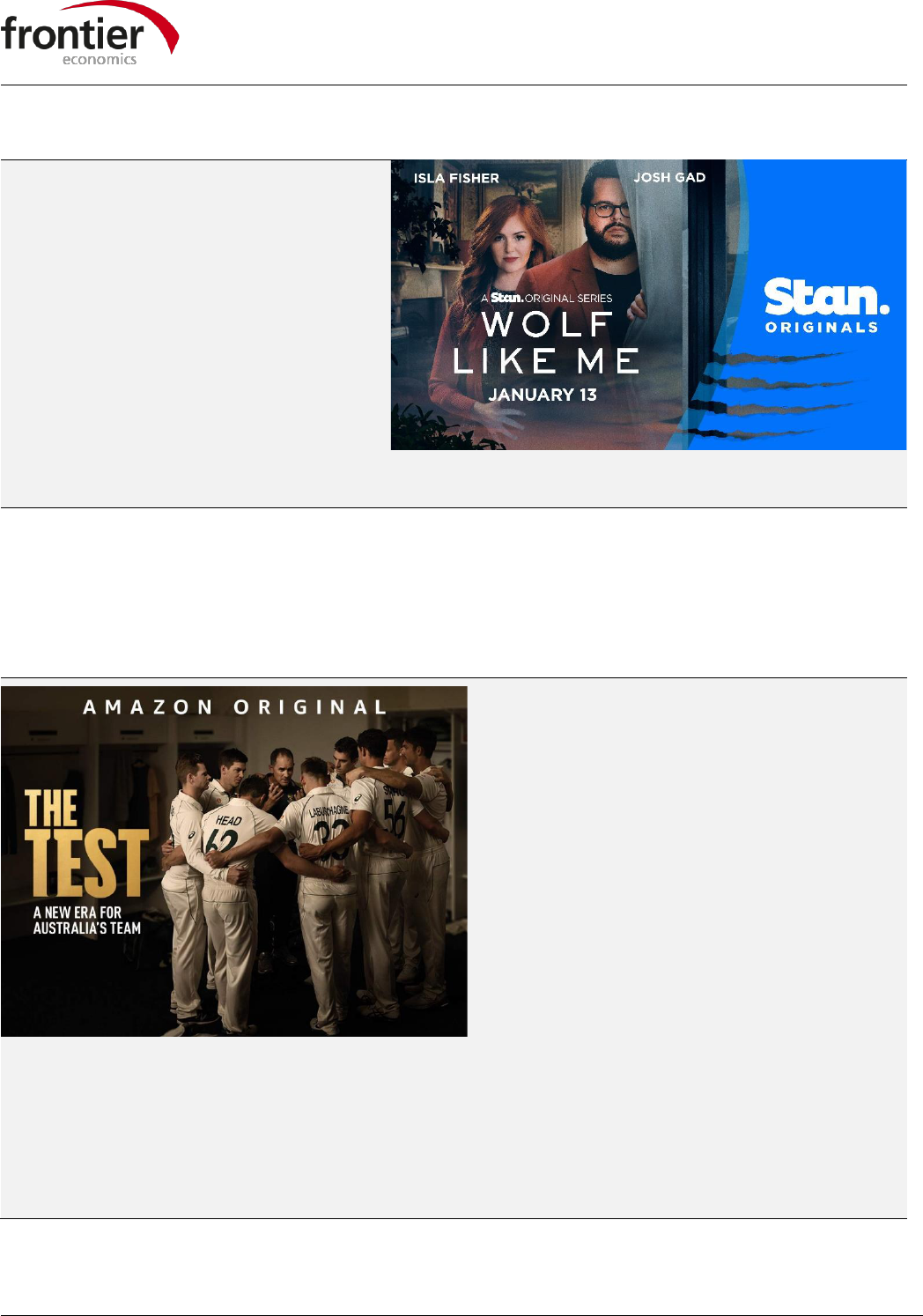
WWW.FRONTIER-ECONOMICS.COM | 11
CASE STUDY – CONTENT INVESTMENT IN AUSTRALIA:
WOLF LIKE ME
Stan Original series Wolf Like Me, brought
together some of Australia’s top acting,
directing and production talent to work
alongside some of the biggest names in
film and television from around the world.
Australian actress Isla Fisher starred
alongside Josh Gad. The show was
produced by Made Up Stories and written
and directed by Australian Abe Forsythe.
Filmed in NSW, Wolf Like Me was co-
commissioned by Stan and NBCUniversal’s
Peacock streaming service, which exhibited the title in the United States, while Endeavor Content is
handling international distribution of the series.
CASE STUDY - CONTENT INVESTMENT IN AUSTRALIA:
THE TEST: A NEW ERA FOR AUSTRALIA’S TEAM
Amazon Prime Video’s first Australian Original
was released in 2019. The Test: A New Era for
Australia's Team, gave an insight into the inner
sanctum of the Australian Men’s Cricket Team
through the players own voices.
The Test is produced by Cricket Australia Films
in partnership with Australian production
company Whooshka Media, involving a majority
Australian cast and crew and directed by
Australian Adrian Brown. Richard Ostroff, Head
of Broadcast & Production at Cricket Australia,
said that “The Test: A New Era for Australia’s
Team captured the inside story of the Australian
Men’s Team during a remarkable period for the
national game. Amazon Prime Video were terrific partners and collaborators on the project, which
employed over 60 Australian production specialists over an 18 month period. We are grateful for their
support and investment from Amazon Prime Video, which enabled this vital story to be told and distributed
to a vast global audience.”
The Test became an international success for Amazon Prime Video in cricket loving territories including
India, New Zealand and the UK.
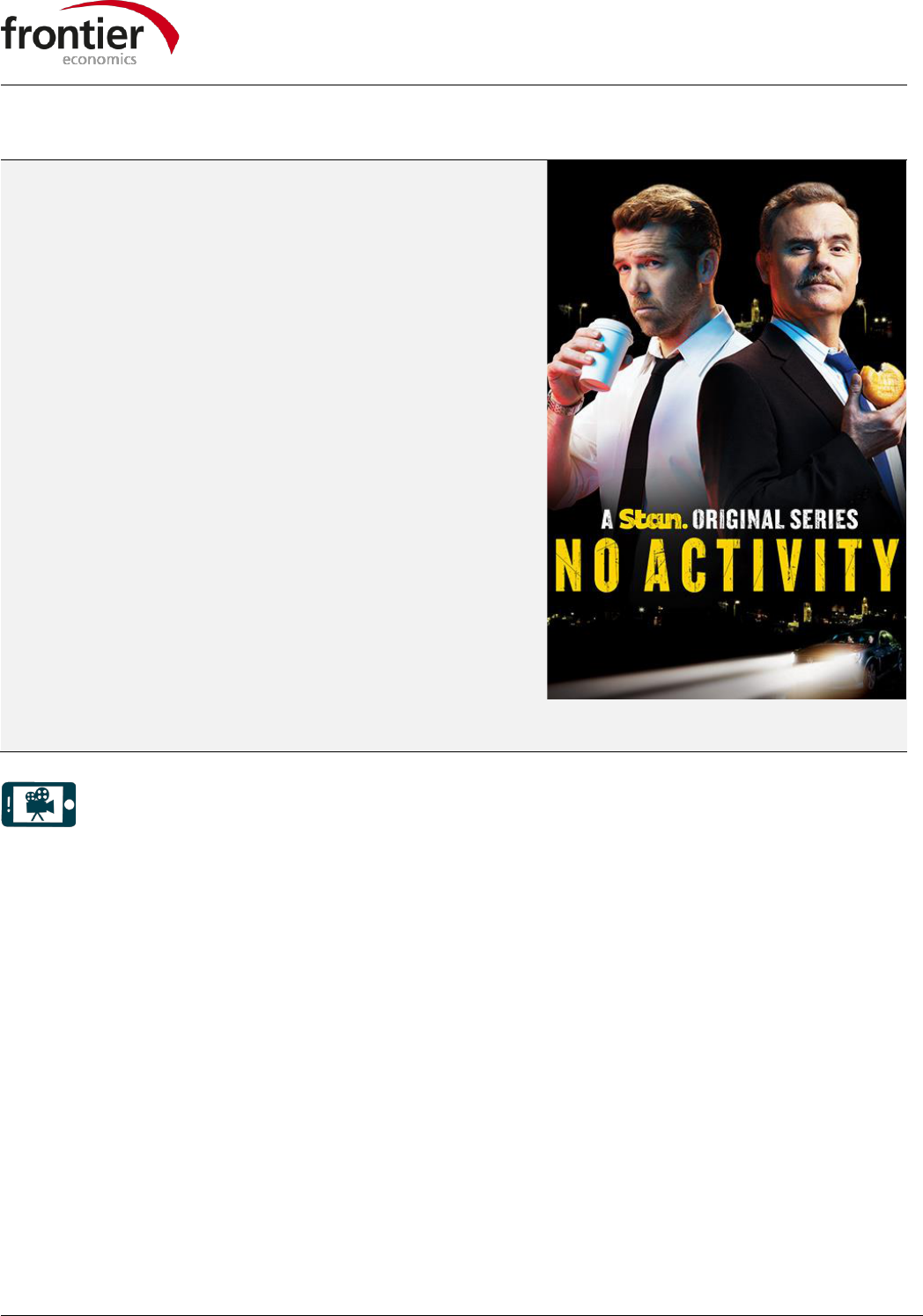
WWW.FRONTIER-ECONOMICS.COM | 12
CASE STUDY – CONTENT INVESTMENT IN AUSTRALIA:
NO ACTIVITY
Just two months after launch in January 2015, Stan
commissioned its first local production, the comedy series
No Activity, produced by Jungle Entertainment which
returned on Stan for a second season and a Christmas
special.
Its success led the Australian series to be distributed into a
number of overseas markets and the format rights for the
series, created by Trent O’Donnell and Patrick Brammall,
were licensed to CBS for a US adaptation in 2017. Produced
by Will Ferrell’s Funny or Die production company, No
Activity (US) ran for three seasons on CBS All Access before
being renewed for an animated fourth season that premiered
on Paramount+ in the US. Alongside the US adaptation, the
format has been picked up for adaptation in markets
including the Middle East, Japan, Spain, Germany, and the
Netherlands.
Jungle Entertainment chief executive Jason Burrows said it
was pleasing to see the original No Activity sold to prestige
platforms including the BBC in the UK and Hulu in the US. “It
has also been very rewarding to see it become one of the
highest selling comedy formats of all time, with seven different
foreign remakes to date, including a US version starring some of the biggest stars on the planet.”
46
INVESTMENTS BRING WIDER ECONOMIC BENEFITS
7. VOD services’ investments are spurring skills, innovation and infrastructure
Content investments by global VOD services and the media companies backing them create indirect
economic benefits for the broader AV sector. Policymakers should consider these benefits when setting the
policy and regulatory environment. The benefits include skills growth and knowledge sharing, growth in
the productive capabilities and capacity of the sector from infrastructure investments, and greater
diffusion of innovations. These wider benefits can also be accrued through co-production partnerships
between VOD services and local producers or broadcasters.
The role that VOD services play in building and supporting the skills base and sector infrastructure is
particularly important at a time where there have been reports of skills shortages and constrained supply
of production infrastructure.
47
Training and skills: VOD services run a range of training and skills programmes in Australia. For
example:
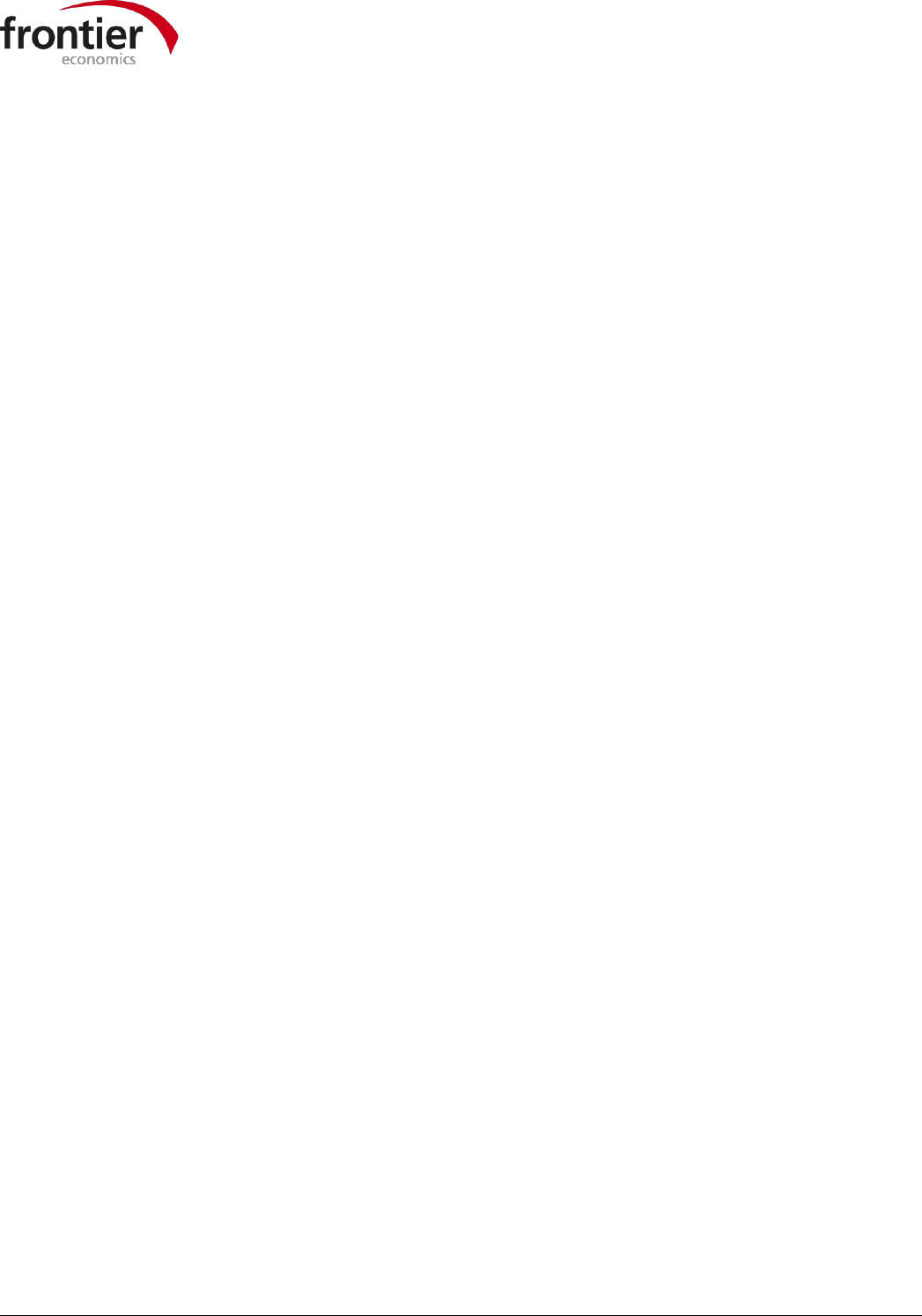
WWW.FRONTIER-ECONOMICS.COM | 13
Netflix recently partnered with Screenworks and the NSW Government to provide free
training for up-and-coming creatives. Backed by a AUD500,000 investment by Netflix, the
Regional Crew Development Program will also provide placements and work experience on
real productions with the goal of creating new career pathways in the field for regional
people.
48
Stan’s recently launched partnership with the Australian Children’s Television Foundation
will include the production and development of Australian live action projects for young
and family audiences. Stan also has active development initiatives in place with State
screen agencies, Screen Queensland, Film Victoria, Screenwest, and the South Australian
Film Corporation, with similar funds currently being explored with other States.
Disney, through ILM, and in partnership with the NSW Government co-invested up to
AUD6m in the Sydney-based Jedi Academy, helping to create as many as 500 jobs over
five years.
49
Innovation: The visual effects company Industrial Light & Magic (ILM), owned by Disney, is a leader
in innovative visual effects in film. Many ILM innovations have helped films win Oscars for visual
effects. ILM continues to invest in offices and hubs around the world, including in Sydney. Recently
ILM has been innovating by producing an end-to-end virtual production solution called StageCraft
which allows for virtual reality testing and production. ILM has now built one, only the fourth in
the world, in Sydney which will be available to be used on future productions.
50
Luke Hetherington,
ILM Executive in Charge, Singapore and Sydney Studios said “The opportunity to set StageCraft up
right on the doorstep of ILM’s Sydney studio was incredibly exciting. StageCraft is a great example of
ILM innovating to help filmmakers tell their stories in new ways, and building that knowledge and
those skills right here in Sydney is amazing.”
51
Sector infrastructure: As well as incentivizing investment through increased demand for
production space, VOD services invest in infrastructure too. For example:
Disney owns Fox Studios which is the largest production facility in the Southern
Hemisphere. It provides a full working ecosystem including pre-production, physical
production and post production. The studio has been utilised by a significant amount of
Australian productions including scripted drama, light entertainment, documentaries and
feature films. The lot includes an industry ecosystem of third party Australian businesses
employing roughly 2,000 people.
Netflix’s Post-Production Partner programme is profiting local firms such as Cutting Edge,
Silver Trak Digital and Soundfirm. The collaborative scheme aims to improve the quality of
post-production elements such as dubbing, audio description, scripting and quality
control.
52
Wider benefits from co-productions: VOD services have partnered with local players on co-
productions of projects such as Dive Club which was recently co-commissioned by Netflix and
Network 10 and The Unlisted (ABC and Netflix). Co-producing content with local partners can
support positive outcomes for producers and consumers in a number ways. First, co-productions
can more efficiently share risk and thereby increase the scope for higher quality and bigger budget
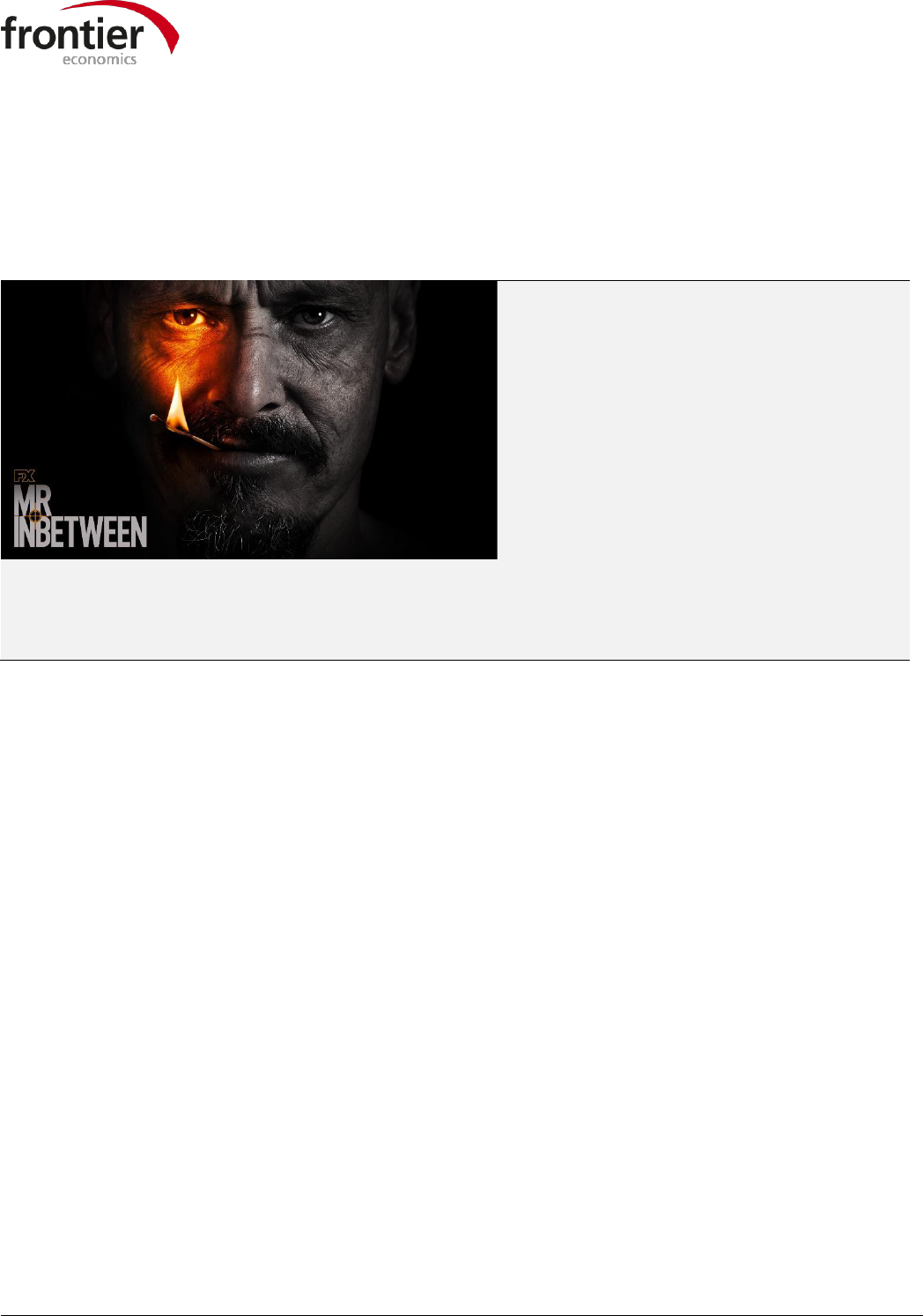
WWW.FRONTIER-ECONOMICS.COM | 14
productions. Second, the close commercial relationship between VOD services and local producers
supports the diffusion of innovation and skills around Australia’s AV sector. Third, co-productions
enable Australian content to reach wide domestic audiences on free-to-air services, while also
finding global audiences on subscription VOD services.
CASE STUDY – CONTENT INVESTMENT IN AUSTRALIA:
MR.INBETWEEN
Mr. Inbetween is a critically acclaimed
Australian series that, for seasons two and
three, was funded by Disney-owned FX and
licensed to Foxtel for viewing in Australia.
Globally, the series is available on Disney-
owned Hulu in the US and Disney+ in many
other countries around the world. The
production’s entire cast, crew and writers
were Australian with the production shot in
New South Wales.
53
This production, similar to other case studies
shown here, was a collaborative production
and highlights the complex investment relationships that exist between VOD services, production studios
and broadcasters.
8. VOD services’ investments are producing broader benefits for Australia
VOD investments bear fruit beyond the AV sector. The creative industries generate disproportionately wide
economic impacts. Specifically, the industry can connect people, cut across cultural and political divides,
and act as a source of identity and expression. Content and stories are a powerful tool to aid national
integration, deliver social messages and project Australia’s culture and influence on the global stage.
Through diversified local investment, training partnerships and key content decisions, VOD services can
help achieve broader social goals and positively impact the community.
The Bunya Indigenous Talent Hub is a talent incubator and global networking program that was
run in 2020 in partnership between Netflix and Screen Australia. It was open to Indigenous writers,
showrunners, directors and producers who developed and pitched a film or television project to
content executives from Netflix and other industry practitioners.
54
Netflix has also partnered with the Australian Film Television and Radio School (AFTRS) to set up
the Netflix Indigenous Scholarship Fund.
55
Netflix will provide AUD515,000 to the Fund for a
range of initiatives to elevate Indigenous creatives and voices in the Australian screen and
broadcast industries and support Australia’s First Nations communities and storytellers. The fund
aims to support individual careers and improve the inclusion and cultural capacity of the industry.
Netflix and Australian charity Support Act launched a AUD1m COVID-19 film and TV emergency
relief fund. The aim was to help and support casual workers who lost their jobs when productions
were shut down or postponed.
56
Mr Inbetween is available on Foxtel on demand © FX Networks LLC
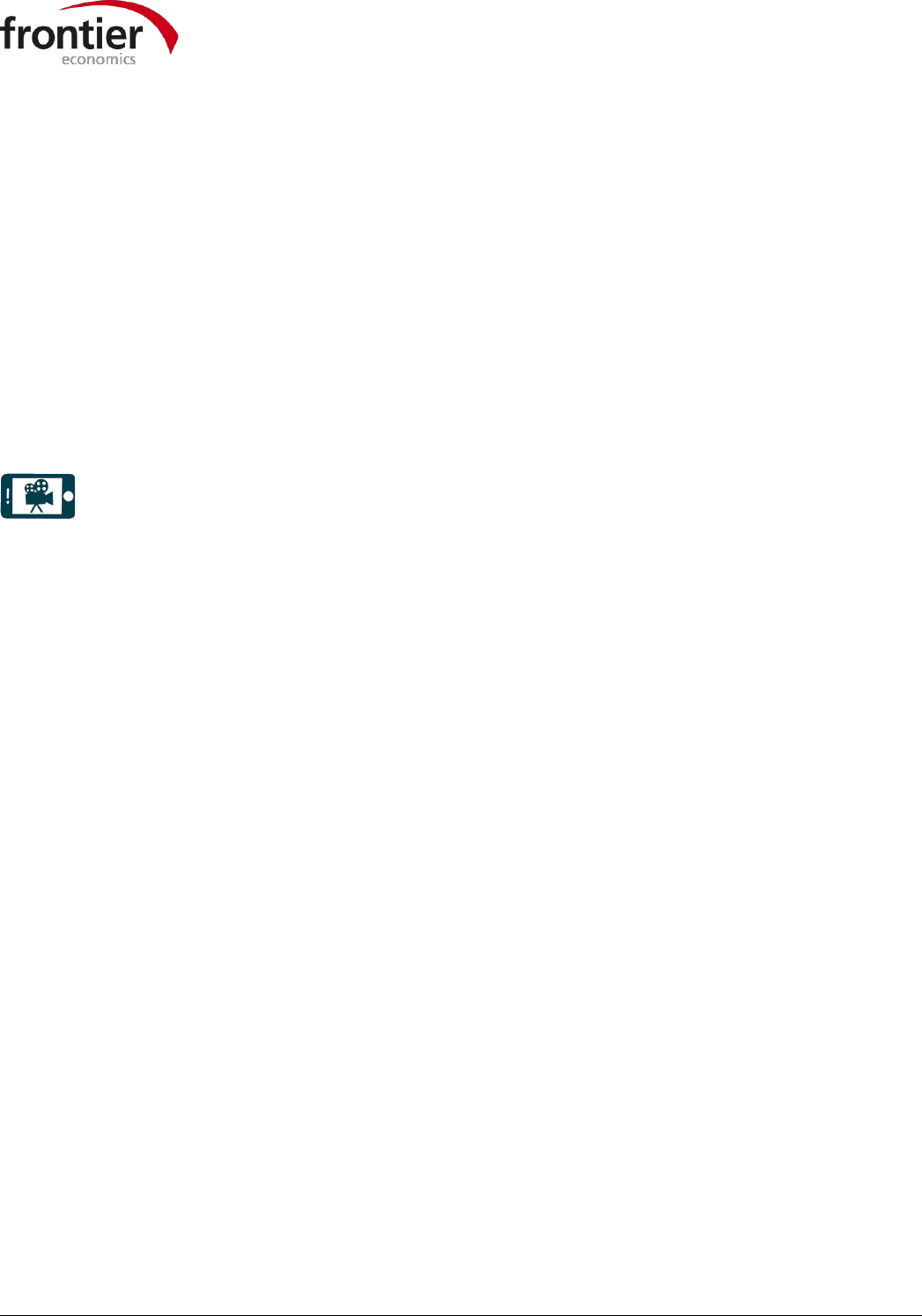
WWW.FRONTIER-ECONOMICS.COM | 15
Investing in content can attract tourists who want to see where their favourite show was shot. VOD
services, with their ability to bring Australian content to a global audience, are exceptionally well placed to
stimulate tourism and produce wider reputational benefits for Australia, long after a title’s initial release.
By showcasing Australia, VOD raises the country’s international profile and reputation. Content-induced
tourism is on the rise. A TripAdvisor survey suggested that 20% of global travellers have visited a
destination because they saw it in a TV show or movie.
57
On-screen content attracts around 230,000 international visitors to Australia each year, driving an
estimated AUD725m in tourism expenditure.
58
Research has shown that content helps to create connections between viewers and locations
through scenes on screen. The connections can lead to a growing cultural affinity with the country
leading to more interest in that country, including products from that country and potential
tourism.
59
HELP INVESTMENT, DON’T HINDER IT
9. Pro-investment policies can keep Australia’s AV sector growing
Australia benefits when policies attract investment in content and in the wider AV ecosystem. This high-
value-added activity makes a disproportionately large contribution to GDP, it provides skilled, well-paid
employment, and supports a country’s exports.
However, production of top-quality content is costly. It requires sector-specific infrastructure, state-of-the-
art technology, complex production processes and large crews of highly trained specialists from many
different trades. At the same time, content creation - like any art form - is a risky investment.
Policies such as tax rebates or grants that mitigate the risk and high fixed costs of content creation have
been found to significantly increase content investments.
60
Australia has been successful in attracting
international investment through a number of federal and provincial schemes such as the Location
Incentive grant, the Location Offset tax rebate and the Producer Offset rebate.
Since being launched in July 2019, 23 productions have been drawn to Australia through the
Location Incentive program. These productions are expected to generate around AUD1.7bn of
expenditure and, importantly, are creating a sustained pipeline of work for Australians, generating
more than 15,800 jobs for local cast and crew, and using the services of more than 15,200
Australian businesses.
61
Dr. George Miller, the director of the upcoming film Furiosa, said that federal and state incentives
were pivotal to Furiosa being produced in Australia. The WarnerBros film will be shot in New South
Wales and state premier Gladys Berejiklian said “This is great news for New South Wales – Furiosa is
expected to support more than 850 local jobs and bring around AUD350m into the New South
Wales economy”.
62
The Producer and PDV offsets supported 213 Australian children’s drama, documentary and
entertainment productions in 2020/21.
63
The addition of AUD400m to the Incentive grant and the increase in the Producer Offset from 20% to 30%
for eligible formats in the last year have continued to send the right signals to global investors and kept

WWW.FRONTIER-ECONOMICS.COM | 16
the incentives to invest high.
64
In addition, the AUD50m Temporary Interruption Fund supported the
industry through the pandemic ensuring Australian content production was not lost.
Policymakers can also ensure a strong supply of skilled, high-value workers by supporting training
programmes that will benefit both global and local players active in Australia. The government’s improved
incentives, along with the growth in investment driven by VOD services, has created strong demand for
local and global content production in Australia which is now generating demand for more skilled workers
and production infrastructure. A survey conducted by Screen Producers Australia confirmed this showing
that over 80% of producers surveyed faced increased challenges staffing their projects and over 95%
report increased crew costs.
65
Global content producers invest in Australia to access a highly skilled
workforce as well as state-of-the-art studio infrastructure and a rich ecosystem of suppliers. This
attractiveness needs to be maintained and built on to ensure high quality, high impact investments
continue to be made in Australia.
INCENTIVES AND HIGH QUALITY INFRASTRUCTURE SUPPORT INVESTMENT IN THE AUSTRALIAN SECTOR
Disney+ original series Nautilus highlights how the
combination of Australian incentives and high quality
infrastructure and talent attracts investment.
Nautilus is to be produced in Australia with AUD23.3m
of assistance from the Location Incentive grant program.
66
The series will be filmed in Queensland at Village
Roadshow Studios and will also be supported by the
Screen Queensland’s Production Attraction Strategy,
thereby showing the impact incentive policies can have.
Kate Marks, CEO, Ausfilm said that “it is promising to see
that Australia has been chosen yet again to film another major international project, which is undoubtedly a
result of the Morrison Government’s Location Incentive program combined with state government support
from the Queensland Premier and the incredible reputation of Australia’s talented cast, crew and facilities.”
67
As a return on these incentives the production is expected to create more than AUD172m of local
economic activity through jobs and local spending.
Government policies, including regional and federal grants and rebates to incentivise and support media
investment, can have large multiplier effects on the wider economy and on the government’s fiscal
position. These can outweigh the costs of polices to attract investment. For example, by 2016-17 the
production incentives had added AUD3.86 in GVA for each dollar in offset awarded. In addition, the cost
of the offsets had been recovered as the additional economic activity from the offsets paid an average of
AUD1.05 in taxes back to the government for each dollar in incentive granted.
68
A policy framework that encourages investment by VOD services in the AV sector in Australia could
underpin a virtuous circle of investment.
69
Catalysing investment in infrastructure and skills enhances the
industry’s capacity and capabilities. This, in turn, makes the country an increasingly attractive location for
new investment.
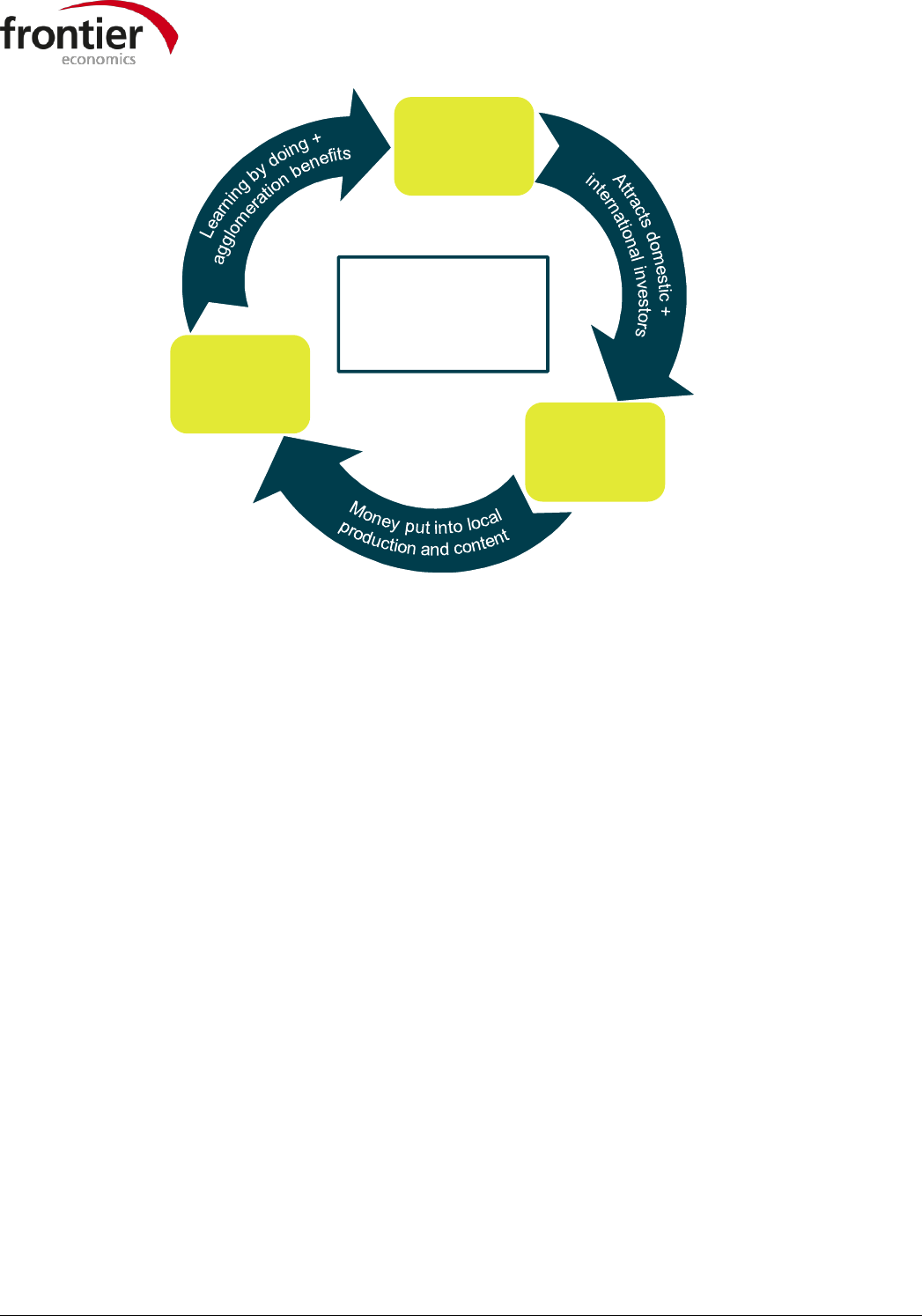
WWW.FRONTIER-ECONOMICS.COM | 17
These policies can nurture the growth of self-sustaining “creative hubs of local production” with global
producers and major studios incentivised to locate and concentrate activities in Australia, to the benefit
the local economy.
70
Investment by major global studios and VOD services in Australia has supported the development of a
thriving local creative economy. The same global studios have established production hubs, investing in
infrastructure to support production, post-production and VFX and their investments have encouraged
investments by other players in the industry too.
Disney’s Fox Studios in Sydney has attracted some of the largest and most iconic international
feature films ever produced since opening in 1998. As well as increased production, the site has
seen increased investment with studio expansions and has now attracted over 50 support
businesses to be based on the studio complex providing services such as lighting, camera and
textiles hire, casting and editing. The support businesses, plus the ILM academy and training
facilitiy nearby have helped it become a production hub in Australia.
71
Increased content investments across Australia have led to government and state infrastructure
investments to create hubs. For example, a AUD150m investment to create a hub of studios in
Penrith,
72
Western Sydney and the expansion of the Docklands Studio Melbourne hub with a water
tank super stage.
73
Investments have been made to establish new film studios at Coffs Harbour and to build a Bryon
Studios production facility near Ballina in New South Wales in response to rising demand.
74
Also a
AUD100m investment has been proposed by local government to build a studio and sound stage
in Fremantle, Western Australia.
75
Infrastructure
and skills
Investment
Local
production
Virtuous cycle
of investment
and skills
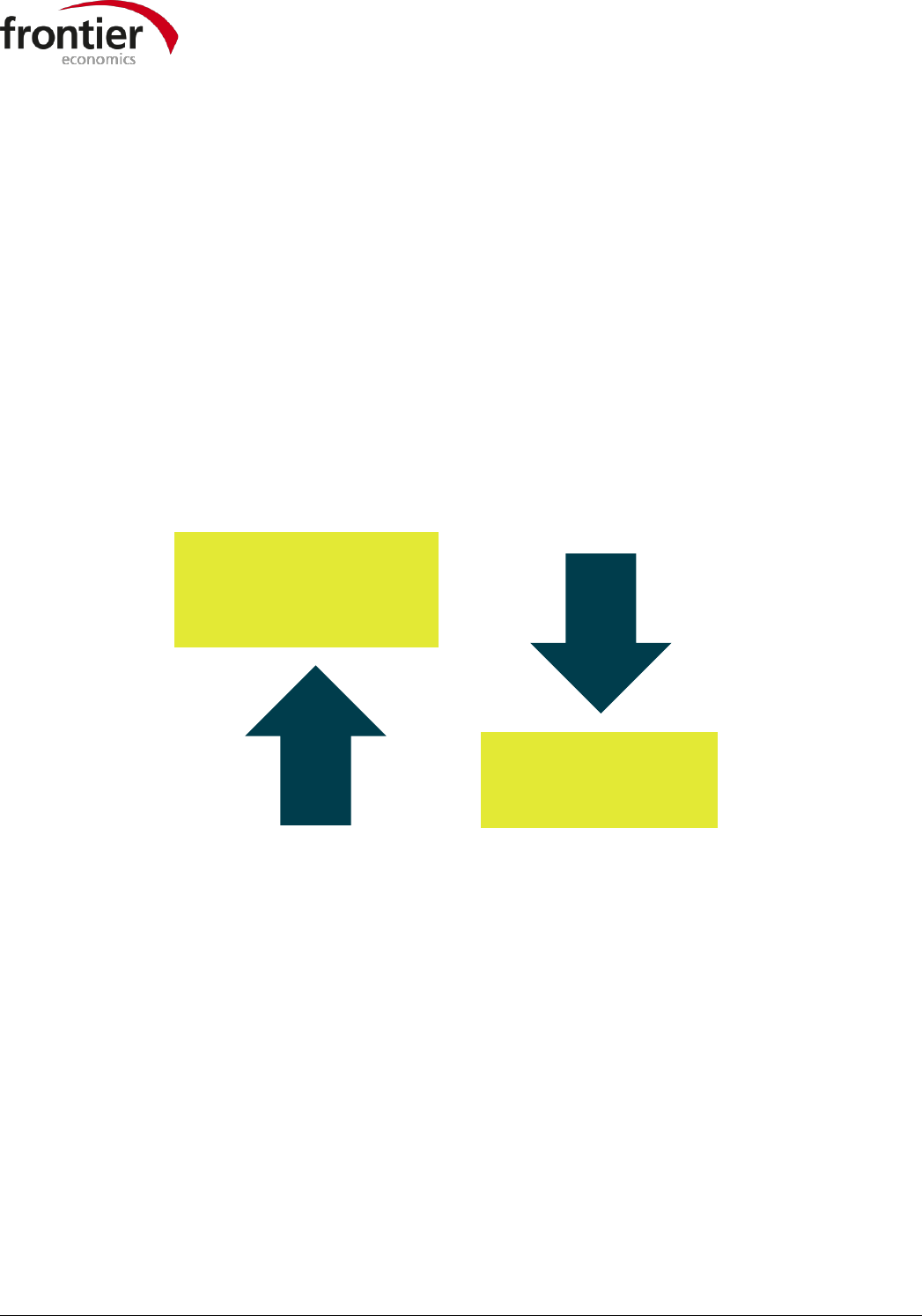
WWW.FRONTIER-ECONOMICS.COM | 18
Policies that discourage or constrain foreign investment or market entry, or reduce investment flexibility
can disrupt this virtuous cycle. Instead of the local AV sector enjoying rising investment, cutting-edge
infrastructure and ever-higher skill levels, more “protectionist” policies may hamper innovation and
growth opportunities in the long run.
76
10. Our research finds that protectionist policies can hurt the economic potential of local AV industries
“Protectionist” policies intended to shield local companies from international competition could result in
local industries that are inward-looking, less innovative and less able to produce high-quality content that
is in demand internationally. Many countries have cultural policies aimed at promoting local content, but
some come at a cost and prove ineffective at achieving the goals they pursue. Our analysis, which
examined the relationship between protectionist policies and AV trade (i.e. licensing content
internationally), found that higher levels of protection (for example the introduction of content quotas)
lead to reductions in AV exports.
77
This implies that countries with more-protectionist policies are less
able to monetise their content in international markets, or show off and promote their culture to audiences
around the world.
11. Put up barriers and you may put off investors in content
Countries that have greater policy restrictions tend to have lower levels of investment in content. While
there are many other factors at play,
78
Figure 5 below is consistent with the hypothesis that protectionist
policies discourage content investment (at least for the countries selected). The result of lower content
investment is inevitably lower employment and skills development in the sector.
FOR EXAMPLE, INCREASING AV
POLICY RESTRICTIONS, EQUIVALENT
TO INTRODUCING QUOTAS FOR
BROADCAST TIME…
…REDUCED BROADCASTING
EXPORTS IN THAT COUNTRY BY
4.3%.
…LEADS TO…
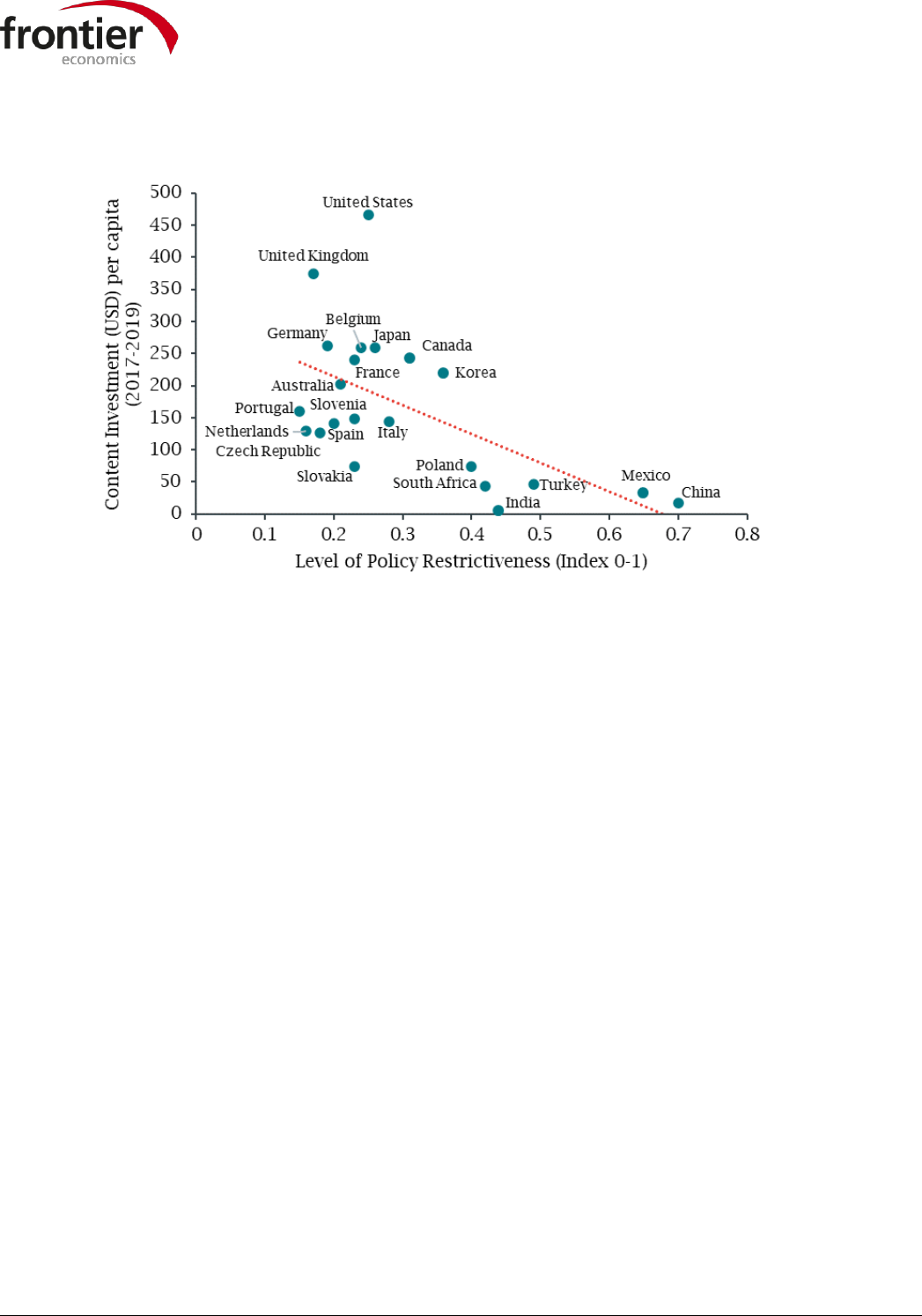
WWW.FRONTIER-ECONOMICS.COM | 19
FIGURE 5 RESTRICTIVE AV POLICY CORRELATES TO LOWER INVESTMENT (SELECTED OECD
COUNTRIES AND CHINA)
Source: Frontier analysis of Ampere and OECD data
Note: All values of content investment are nominal. For each country, content investment data includes investment by commercial and public
broadcasters and also by selected VOD services, where spend can be disaggregated by country. Excludes any investment in sports rights. Countries
were selected based on data availability and include OECD countries and China. The level of policy restrictiveness is the OECD’s broadcasting
sector specific Services Trade Restrictiveness Index (STRI) which captures the level and range of non-tariff barriers in services trade within the
broadcasting sector. The STRI is a widely used measure of policy restrictions on services used by academics and policy makers. The STRI is an
index between zero and one attributed to each country, where zero would imply no policy restrictions, and one the highest possible policy
restrictions.
12. Restrictions reduce incentives
Australia is home to a growing AV industry, though VOD services in Australia are relatively recent
additions to the AV sector, with domestic and international VOD services launching later than in some
other countries and new services launching each year. Policymakers can encourage this growth to continue
in a way that continues to benefit the local creative sector and the broader economy. While protectionist
restrictions (such as expenditure obligations, content quotas, conditional visas for foreign actors and
broadcast quotas) have a number of legitimate policy objectives (such as supporting the creation or
consumption of local cultural content, or helping the domestic AV sector) they can also have adverse
impacts.
Investment obligations are designed to ensure sufficient levels of investment in local content, but
implementing them can have unintended consequences such as;
Reduction in flexibility of investment decisions may lead to investment in titles to fit a
quota rather than to meet audience demand. Lower flexibility may also reduce the ability
to experiment with content missing out on future potential production and content
innovations.
Increased pressure on production facilities could potentially lead to cost inflation which
may reduce the level of future investment.

WWW.FRONTIER-ECONOMICS.COM | 20
Investment quotas combined with restrictive local content definitions might lead to more
homogenous content and services and less scope for innovation and less ability to scope
services to specific consumer needs. Such homogeneity might impact competition and the
ability of local or regional services to differentiate.
Restrictions can drive up costs for domestic and foreign companies, reducing competition and
raising prices for consumers.
79
This cost may be particularly relevant in Australia where production
facilities and crew are already in high demand, so additional demand may just inflate prices in the
near to medium term.
Policy restrictions that erect barriers to inward investment deter the influx of international capital,
talent and skills, and can restrict the adoption of new techniques and innovations that inbound
investment brings.
Onerous definitions of local content for the purpose of defining local content obligations, can
discourage investment in local content and the local industry.
80
In the Media content consumption
survey 2020, ‘Made in Australia’ was the criteria considered by most Australian adults (74%) as
what makes media content ‘Australian’. This could suggest that additional criteria beyond this may
not only be restrictive for producers but also unimportant to consumers.
81
Broadcast-time quotas are designed to nudge consumers towards local content but implementing
them for VOD services can be problematic.
Quotas applied to VOD services may not be effective in changing tastes, as consumers
choose their content on demand.
82
Quotas can distort incentives, as services are motivated to focus on the quantity of local
content rather than its quality, which could have less of an economic impact.
83
84
VOD services may reduce the size of their overall libraries in proportion to the volume of
local content that they are able to license, leading to less choice for consumers and less
investment in wider production by VOD services, without increasing actual volume of local
content.
Quotas can create barriers to entry as they may disproportionately affect smaller VOD
entrants rather than established VOD services with large domestic customer bases or
content libraries.
Where the goal is to increase domestic capacity and capabilities, joint productions with foreign companies
may be more effective than restricting entry or applying additional requirements on international services
in domestic markets.
Restrictive policies may also have the unintended effect of increasing levels of piracy. Piracy drains a
country’s AV economy by reducing the returns on investment and blunting the incentives of creatives to
innovate and produce new content. It also reduces the government’s tax take as legitimate business
revenue streams are hit. 24% of VOD users in Australia have said that they would watch or download VOD
content from unauthorised services if it was not otherwise available, to the detriment of both the country’s
economy and its culture.
85
In summary, some protectionist policies can increase costs, restrict investment and ultimately limit the
content available to local consumers, with potentially further negative consequences for the creative
industries in Australia.
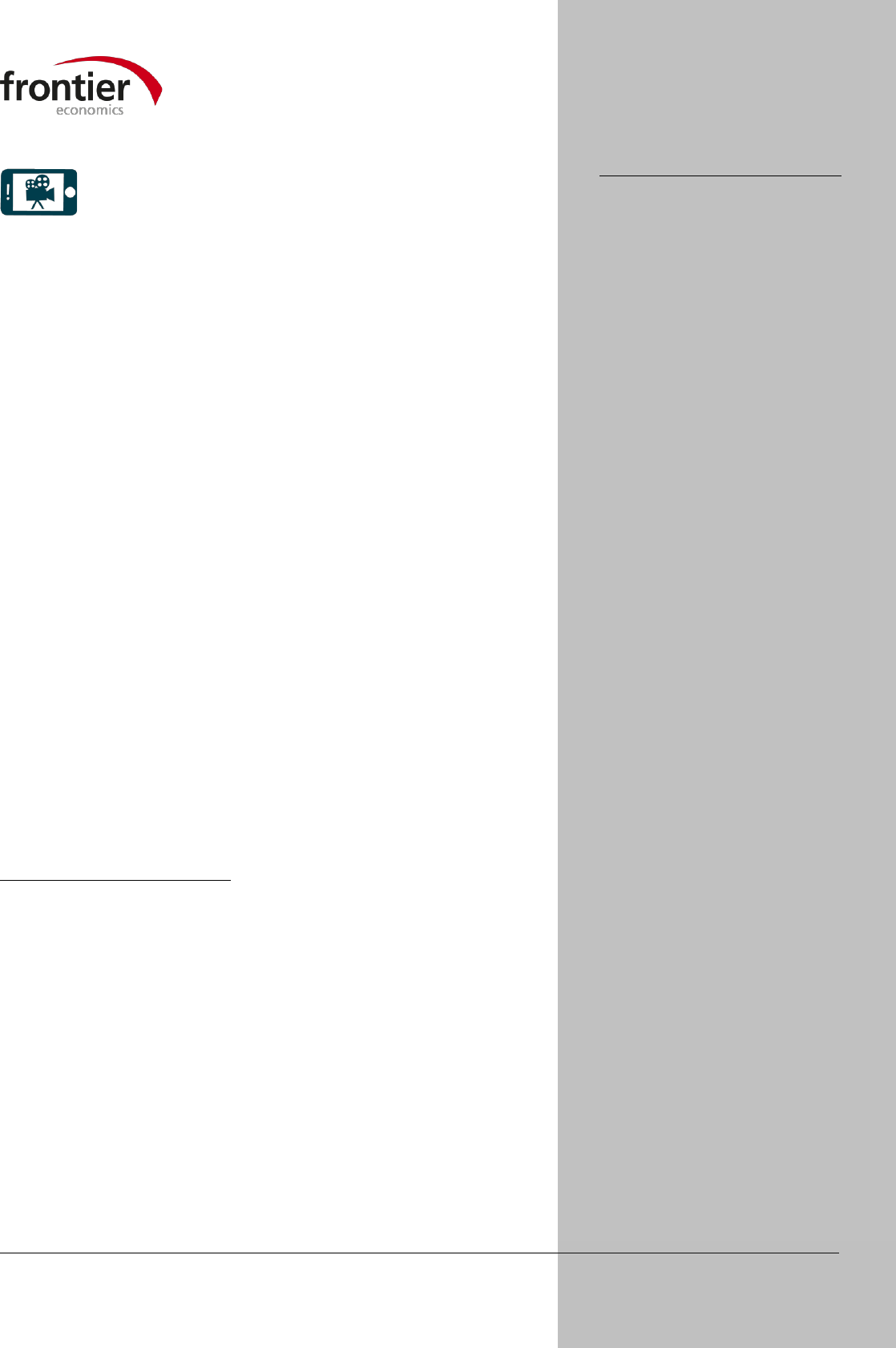
WWW.FRONTIER-ECONOMICS.COM | 21
VOD SERVICES CAN HELP
AUSTRALIA’S AV INDUSTRY
CONTINUE TO THRIVE
Australia has a vibrant film, television and video on-demand
industry, and VOD services in Australia make a significant and
growing economic contribution within that sector. Consumers are
increasingly subscribing to VOD services, which invest in
Australian content that audiences want to watch. VOD services
also act as an international shop window for the country’s culture,
while bringing Australian stories to global audiences.
By carefully calibrating policy and regulations to incentivise
investment while still allowing flexibility in investment decisions,
Australia will enjoy wider benefits such as increased employment,
higher economic output, increased exports, a growing skills base,
and expanding sector infrastructure. This, in turn, creates
conditions to attract new investment. Policymakers should
therefore be mindful of potential unintended consequences of
some types of protectionist policies. These can reduce incentives
to invest, lower sector outputs and exports, raise costs and even
increase piracy. By working with VOD services, producers and
production companies, policymakers can create the right
conditions to support investment and further expand the
flourishing film, television and on-demand industry in Australia,
thereby ensuring the creative sector in Australia will continue to
thrive.
1
VOD subscribers counts the number of paid subscriptions there are to VOD services in Australia. These are
often used by more than one person, usually within the same household.
2
Results are from an online consumer survey of 1,107 Australian internet users (“Kantar Survey”). The survey,
designed by Frontier Economics, was conducted by Kantar between 29
th
September and 20
th
October 2021. See
technical annex for further detail. Question: How often do you watch online subscription services which offer
professionally-produced full length movies, shows or series for a regular fee, such as Netflix, Stan, Disney+ or
Binge? Please exclude services that show videos uploaded by individual users such as YouTube. Base: All
respondents (1,107)
3
Kantar Survey, Question: When you watched your online subscription service(s) last week, how many hours did
you spend watching Australian content? Base: Respondents who watched subscription VOD at least once a week
(802)
4
The average 2020 USD-AUD exchange rate has been used to convert USD figures into AUD. OECD Exchange
Rates.
5
Ampere, Subscription VOD revenue 2020, extracted September 2021
6
Ampere, Subscription VOD revenue forecasts to 2025, extracted September 2021
7
Deadline, With Ambitious Paramount+ Launch, ViacomCBS Targets 65 Million-75 Million Streaming Subs By
2024, February 2021
8
Variety, Inside HBO Max, the $4 Billion Bet to Stand Out in the Streaming Wars, May 2020
9
Fortune, Netflix will spend over $17 billion on content in 2020: Analyst, January 2020
10
ACMA, Spending by subscription video on demand providers 2020–21
AUTHORS
CLIVE KENNY
Frontier Economics
DANIEL LEWIS
Frontier Economics
WANT TO KNOW MORE?
WWW.FRONTIER-ECONOMICS.COM
HELLO@FRONTIER-ECONOMICS.COM
+44 (0) 207 031 7000

WWW.FRONTIER-ECONOMICS.COM | 22
11
The definition used for an Australian program is consistent with Section 10 of the Broadcasting Services (Australian Content and Children’s Television) Standards 2020
12
As stated in the ACMA report, Spending by subscription video on demand providers 2020–21, ‘Australian-related’ programs are classified as shows that meet at least one criteria
of an ‘Australian program’. For example, at least one aspect of creative control is performed by an Australian.
13
ACMA, Spending by subscription video on demand providers 2019–20
14
The Sydney Morning Herald, Room for one more? Paramount+ to hit Australian screens this winter, May 2021
15
C21Media, ViacomCBS orders trio of formats from Endemol Shine Australia for 10, Paramount+, October 2021
16
Stan submission to Media Reform Green Paper, May 2021
17
Screen hub, Amazon Prime Video greenlights seven new Australian productions, May 2021
18
The Sydney Morning Herald, 'Quality is fantastic': Netflix reveals $110m spend on Australian children's shows, August 2020
19
Netflix submission to Media Reform Green Paper, May 2021
20
Screen Australia, Drama Report - Production of feature films, TV and online drama in Australia in 2020/21, p.25 - 2021
21
Olsberg•SPI, Global Screen Production – The Impact of Film and Television Production on Economic Recovery from COVID-19, June 2020
22
Australian Government, Media Reform Green Paper – Modernising television regulation in Australia, November 2020
23
ACMA, Spending by subscription video on demand providers 2020–21
24
Screen Australia, Drama Report - Production of feature films, TV and online drama in Australia in 2020/21, 2021
25
Screen Australia, Drama Report - Production of feature films, TV and online drama in Australia in 2020/21, p.30 - 2021
26
ViacomCBS submission to Media Reform Green Paper, May 2021
27
ausfilm, DORA EXPLORES THE GOLD COAST ,October 2019
28
Streaming industry submission (Disney+, Netflix, Stan, Prime Video) in response to the Options Paper Supporting Australian Stories on our screens, July 2020
29
Screen NSW, Marvel Studios to film “Thor: Love and Thunder” in Australia
30
The Sydney Morning Herald, Has Shantaram curse finally lifted? Production to restart, 15 months on, April 2021
31
Paul Fletcher MP, Netflix partners with Victorian creators to bring ‘Clickbait’ to Melbourne, August 2019
32
Paul Fletcher MP, Hit television series The Wilds set to film in Queensland Starring Rachel Griffiths, Mia Healey, and Shannon Berry, February 2021
33
Redland City Council News, Minjerribah sets the scene for The Wilds filming, September 2021
34
Kantar Survey
35
Kantar Survey, Question: When you watched your online subscription service(s) last week, how many hours did you spend watching Australian content? Base: Respondents who
watched subscription VOD at least once a week (802). This is consistent with other research done across APAC countries (AlphaBeta, Asia-On-Demand, 2018).
36
Kantar Survey, Question: Considering all TV and video services you use, how important is it that your TV and video services provide the following types of content on a scale of 1-5?
Scale; 1 = Not important to me at all, 2 = somewhat unimportant, 3 = neutral, 4 = quite important to me, 5 = Very important to me. The content types were content that includes
people like me, content that represents where I live, content which represents an authentic portrayal of the region where I live, content that is made in Australia, content that is
relevant to my life, content that is made by people from Australia. The result shown here is the proportion of respondents that felt it was quite or very important that their TV
and video services provide at least one of the types of content related to Australian content (content that represents where I live, content which represents an authentic portrayal
of the region where I live, content that is made in Australia, content that is made by people from Australia). Results for the other two content types, representative content, were
not used, but results were similar. Base: All respondents (1,107)
37
Kantar Survey, Question: Considering the online subscription service(s) you use, how well do they provide content that is made specifically for Australians for example, telling
stories about people in Australia, or with actors or presenters from Australia? ? Scale: 1 = Does not provide any content that is made specifically for Australians at all, 2 = Does not
provide enough content that is made specifically Australians, 3 = Provides some content that is made specifically for Australians, 4 = Provides a good level of content that is
made specifically for Australians and 5 = Provides the best possible level of content that is made specifically for Australians. Base: All respondents that use the services at least
once every 3 months (877)
38
Kantar Survey, Question: Considering the online subscription service(s) you use such as Netflix, Stan, Disney+ or Binge, , on a scale of 1-5, how satisfied are you with the with the
amount of content on these services that is made specifically for Australians?? Scale; 1 = Very unsatisfied, 2 = somewhat unsatisfied, 3 = Neutral, 4 = somewhat satisfied, 5 = Very
satisfied. Base: Respondents who watch online subscription services at least once every three months (877)
39
Paul Fletcher, Governing in the Age of the Internet, ACMA, Monash University Publishing 2021
40
ACMA, Spending by subscription video on demand providers 2020–21
41
Screen Australia, SPOTLIGHT ON KIDS’ TV, November 2021
42
Screen Australia, SPOTLIGHT ON KIDS’ TV, November 2021
43
The Sydney Morning Herald, 'Quality is fantastic': Netflix reveals $110m spend on Australian children's shows, August 2020
44
Netflix, Netflix Scripted Thriller Series "Clickbait" Hooks Its First Cast Members, December 2019
45
The Sydney Morning Herald, Australian show Clickbait tops Netflix charts around the world, October 2021
46
Stan.
47
Screen Producers Australia, Local Productions Facing Skills Shortage, April 2021
48
Netflix, New Partnership With Screenworks And Netflix Provides Career Pathways In Booming Screen Industry, August 2021
49
ausfilm, ILM’s Jedi Academy Invests In Inclusion, May 2021
50
ausfilm, Gathering The Forces: Ilm’s Sydney Studio Brings In Global Expertise To Hire And Train Local Talent For Stagecraft Expansion, January 2021
51
ausfilm, Gathering The Forces: Ilm’s Sydney Studio Brings In Global Expertise To Hire And Train Local Talent For StageCraft Expansion, January 2021
52
Netflix Post Partner Program - https://np3.netflixstudios.com/
53
Screen Australia, FX AUSTRALIA COMMISSIONS FIRST LOCAL PRODUCTION, June 2017
54
Screen Australia, Participants Announced For The Bunya Talent Indigenous Hub In LA, January 2020
55
Netflix, AFTRS And Netflix Announce $515,000 Netflix Indigenous Scholarship Fund, June 2021
56
If.com.au, Netflix donates $1 million to help displaced screen industry workers, June 2020
57
TripAdvisor, 6 key travel trends for 2016, December 2015
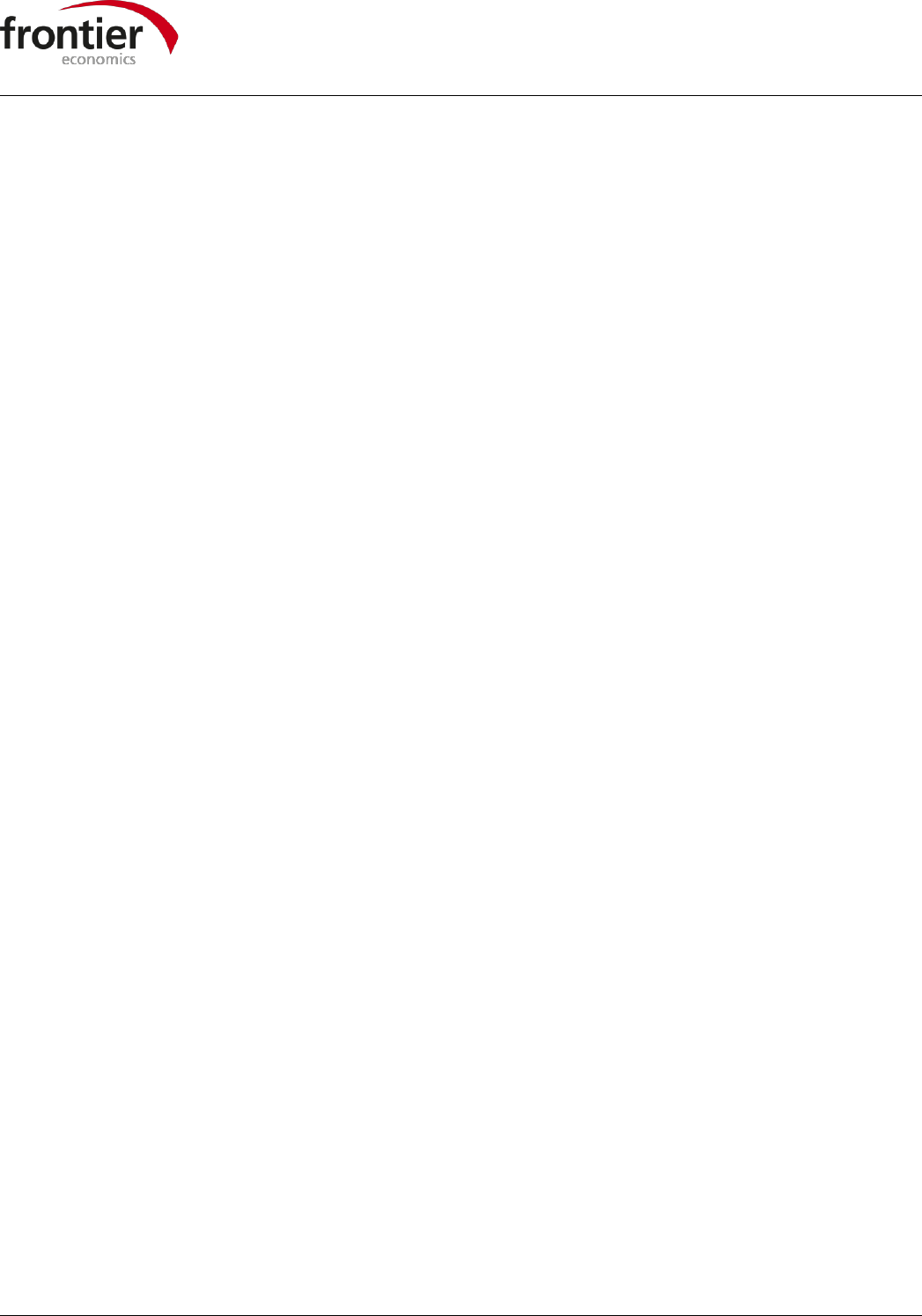
WWW.FRONTIER-ECONOMICS.COM | 23
58
Screen Australia, Screen Currency Valuing Our Screen Industry, 2016
59
World Tourism Organization and Netflix (2021), Cultural Affinity and Screen Tourism – The Case of Internet Entertainment Services, UNWTO, Madrid
60
BFI (2018) How screen sector tax reliefs power economic growth across the UK. Study found that 91% of production would not have occurred absent the tax relief.
61
Paul Fletcher MP, Media Release - Record year of funding: $530 million to support screen sector, August 2021
62
Variety, George Miller’s ‘Furiosa’ Set to Be Australia’s Biggest Film Shoot Ever After Receiving Financial Incentives, April 2021
63
Paul Fletcher MP, Media Release - Record year of funding: $530 million to support screen sector, August 2021
64
The Australian Government added AU$400 million to the Location Incentive grant in July 2020. The grant is available from 1st July 2019 to 30 June 2027. This is in addition to
the AU$140 million announced in May 2018. The grant total is now AU$540 million. In addition, the Australian Government announced changes and updates to the Producer
Offset that will come into effect on 1st July 2021. The changes mentioned in this report are that the rate of the Producer Offset will be raised from 20% to 30% for eligible formats,
such as drama and documentary content for television and streaming platforms. ausfilm – Incentives.
65
Screen Producers Australia, Local Productions Facing Skills Shortage, April 2021
66
Paul Fletcher MP, Media Release - Disney+ Original Series to inject $172 million into Australian economy, August 2021
67
ausfilm, Australia Welcomes Disney+ Original Series Nautilus, August 2021
68
In 2018 Olsberg•SPI analysed the return on investment for the government of the Producer, Location and PDV Offsets available at the time in terms of gross value added and tax
receipts. They calculated that up to financial year 2016-17 the production incentives had added AUD3.86 in GVA for each dollar in offset awarded. In addition, the cost of the
offsets had been recovered as the additional economic activity from the offsets paid an average of AUD1.05 in taxes back to the government for each dollar in incentive granted.
.Olsberg•SPI, Impact of Film and TV Incentives in Australia - A Report for the Australian Screen Association by Olsberg•SPI, March 2018
69
Messerlin. (2019). Building Consistent Policies on Subsidies in the Film Industry. Kritika Kultura, 32, 375-396.
70
Karlsson, C., & Rouchy, P. (2015). Media clusters and metropolitan knowledge economy. Handbook on the Economics of the Media.
71
Fox Studios Australia, Partner Businesses
72
NSW Department of Planning, Industry and Environment, Penrith set to become Australian film and TV capital, August 2021
73
Film Victoria Australia, Melbourne’s New Super Stage And Water Tank Is A Game Changer, 2020
74
Variety, Byron Studios Development to Expand Stage Capacity in Australia, September 2021
75
If.com.au, WA Government promises $100 million studio and $20 million production attraction fund, February 2021
76
Paul Fletcher, Governing in the Internet Age, 2021, p.45 - in the internet era, it is more important than ever to work out what your strengths are – and where you are going to be
good enough to build not just a strong market share in Australia but a strong market share globally
77
This analysis examines the relationship between protectionist policies and audiovisual trade. An econometric model was used that simultaneously estimates how different
factors impact the level of audiovisual trade between countries. This was done in order to correctly isolate the impact of trade restrictiveness on audiovisual exports (as measured
by the OECD’s Services Trade Restrictiveness Index). See technical annex for further detail.
78
Factors that affect the level of investment in a country include the existing capital stock in the sector, the level of income of a country and the level of public investment.
79
OECD. (2015). Emerging Policy Issues: Localisation Barriers to Trade. Paris: OECD Publishing
80
Lee, B., & Bae, H.-S. (2004). The Effect of Screen Quotas on the Self-Sufficiency Ratio in Recent Domestic Film Markets. Journal of Media Economics, 163–176
81
Department of Infrastructure, Transport, Regional Development and Communications, Media content consumption survey, November 2020
82
Picard, R., Davis, C., Papandrea, F., & Park, S. (2016). Platform proliferation and its implications for domestic content policies. Telematics and Informatics, 683-692
83
Anderson, C., Leigh, G., Swimmer, & Wing, S. (1997). An empirical analysis of viewer demand for US programming and the effect of Canadian broadcasting regulations. The
Journal of the Association for Public Policy Analysis and Management, 525-540
84
Crampes, C., & Hollander, A. (2008). The regulation of audiovisual content: quotas and conflicting objectives. Journal of Regulatory Economics 34.3, 195-219
85
Kantar Survey, Question; If the online subscription service that you use became unavailable to you, would you try and watch or download movies, shows and series from that
service from another source, even if it was an unauthorized service, or app?, Scale: 1 = Definitely would not, 2 = Probably would not, 3 = Maybe, 4 = Probably would, 5 = Definitely
would. Base: All respondents that use the service at least once every 3 months (877).
